 Mark Elliott
Mark ElliottYesterday at 7:37pm
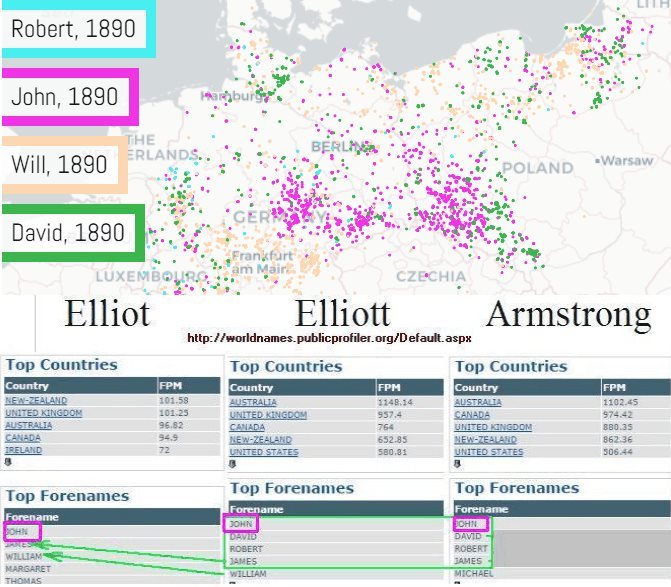
https://nvk.genealogy.net/map/1890:Robert,1890:John,1890:Will,1890:David ‘John’ number one preferred forename among Armstrong-Elliot(t).
Like
Gail Andrews Hardy T124143
15 hours ago
How does this pertain to Northumberland?
Unlike You like this
Mark Elliott
13 hours ago
“The Kingdom of Northumbria was a medieval Anglian kingdom in what is now Northern England and south-east Scotland. The name derives from the Old English Norþan-hymbre meaning “the people or province north of the Humber”, which reflects the approximate southern limit to the kingdom’s territory, the Humber Estuary.” Wikipedia Before Roxburghshire, and Northumberland the name was Danish ‘Northumbria’. At this time the name ‘John’ was likely utilized as a personal name without surname, which came up from today’s southern Poland-Germany region, where the Anglo-Saxon have traveled out of. So the personal of ‘John’, became not a surname, but the promenade for names in the northern region of Northumbria (Lotia-Northumberland), and when the border between the Kingdoms of England and Scotland was placed it was placed across families utilizing the name ‘John’ as a personal name then a forename.
Like
Gail Andrews Hardy T124143
12 hours ago
Maybe so, but what you are showing is the name distribution in Europe, i.e., Germany, the Netherlands, Poland, Austria, Luxembourg.
Unlike You like this
 Mark Elliott
Mark ElliottSeptember 23 @ 9:03pm
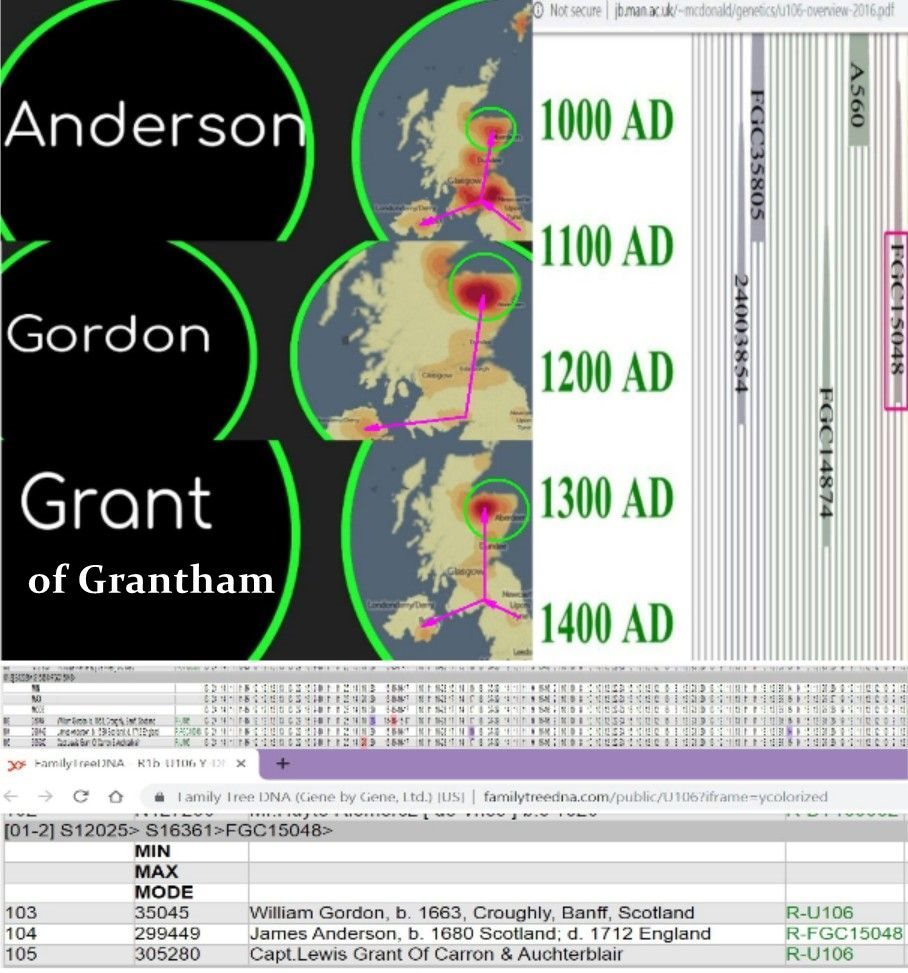
Another example; In this case unique to their surname, these Anderson, Gordon, and Grant are related, likely adopted there surnames near the same time and place. Though it is felt the Anderson name migrated through East Anglia, the Grant surname is from Grantham, and the Gordon surname came from an estate/barony, on the Scottish side of the border likely https://canmore.org.uk/site/64234/lochinvar-castle Lochinvar (lake inward?), with a castle on an island, under water because it became a dammed reservoir. But they the Anderson, Gordon, and Grant are related.
Like
Gail Andrews Hardy T124143
September 24 @ 7:50am
My Anderson connection is through my 8th great grandfather Thomas Reynard Anderson (1640-1690) in Charles City, Virginia, through his son Henry. My Gordon connection is through my 13th and 15th great grandfather, George Gordon (1430-1501), my 16th great grandfather, William Gordon (1440- ? ), my 15th great grandfather, John Gordon (1445-1517), my 13th great grandfather, James Gordon (1500-1547), and my 14th great grandfather, Robert Gordon (1475-1525), These are on different lines. My Grant connection is through my 10th great grandfather, John Grant (1573-1640), and my 11th great grandfather, George Grant (1534-1596).
Unlike You like this
Lynda Crackett
February 11 @ 4:49am
Mark, Are you aware that Anderson is a Scandinavian patronymic, so there are thousands of unrelated Anderson families in Northumberland and elsewhere.
Like
Mark Elliott
Yesterday at 8:36am
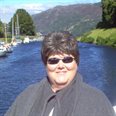 Gail Andrews Hardy T124143
Gail Andrews Hardy T124143January 30 @ 6:10am
FYI: I just got word that Family Search has 557,993 new records from England, Northumberland, Parish Registers, 1538-1950. This was part of an almost 19 million record release in December.
Unlike You like this
 John Wilkinson
John WilkinsonDecember 2 @ 9:50am
If anyone knows of any Hinson/Hanson or Pedersen/Peterson lines in Northumberland, please comment below, preferably with a means to contact them. Many thanks.
Like
Gail Andrews Hardy T124143
January 19 @ 9:17am
I’ve got a Hanson, but she’s in Yorkshire.
Unlike You like this
 Alicia Baker
Alicia BakerDecember 20 @ 7:38am
Help IDing Parents of Lee Hudspeth BIRTH 22 FEB 1893 • Vandalia, Audrain, Missouri, USA DEATH 13 FEB 1965? Married Jennie Idyll Biggerstaff + 1903–1987 BIRTH 31 MAY 1903 • Illinois DEATH 22 AUG 1987 • Nashville, Davidson, Tennessee, USA. Children are Shirley, Phyllis, George, Roberta. Brothers are Fred and Herman.
Like
Mark Elliott
December 20 @ 8:40am
Jennie Idyel Hudspeth (born Biggerstaff), 1903 – 1987 Jennie Idyel Hudspeth was born on May 31 1903, in Illinois, United States, to Charles Biggerstaff and Minnie Mae Biggerstaff. Jennie had 7 siblings: Minnie Genvieve Biggerstaff, Frank Sidney Biggerstaff, Ronald Eugene Biggerstaff, Vera Earnestine Biggerstaff, Rupert A Biggerstaff, Annie Velma Biggerstaff and Robert Biggerstaff. Jennie married Lee Hudspeth on June 23 1932, at age 29 in Morganfield, Union, Kentucky, United States. Jennie lived in 1910, in Crouch Township, Hamilton, Illinois, United States. She lived in 1920, in Crouch Township, Hamilton, Illinois, United States. She lived in 1935, in Alton, Madison, Illinois, United States. She lived in 1940, in Belle Prairie City, Crouch Township, Hamilton, Illinois, United States. Jennie passed away on August 22 1987, at age 84. She was buried in 1987, in East Alton, Madison, Illinois, United States. 4 of 20 records https://www.myheritage.com/names/jennie_biggerstaff https://www.familysearch.org/tree/person/details/GM3Z-KNQ
Like
Alicia Baker
December 31 @ 8:32pm
Thank you Mr. Elliott. I found Lee’s parents and updated my tree with those relatives. Happy to share 🙂
Like
 Mark Elliott
Mark ElliottDecember 12 @ 6:57pm
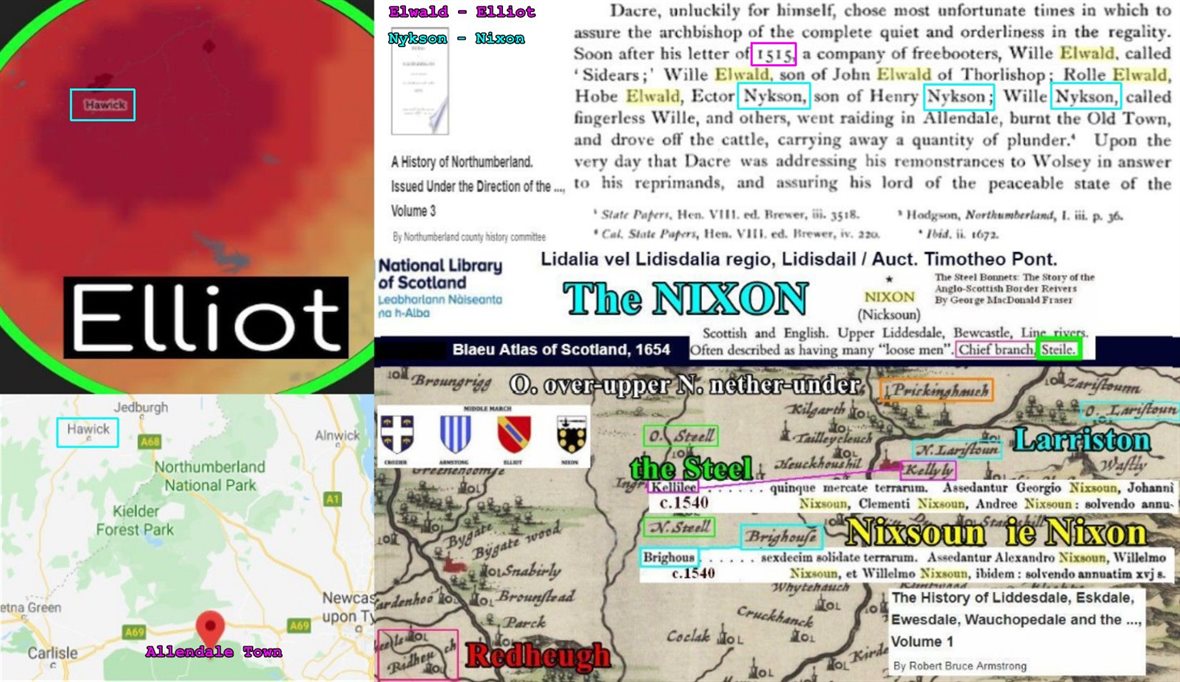
Though do not think out 29th chief Margaret Eliott of Redheugh, has considered anymore raids done towards Hexham lately. The Elliot, and Nixon, consider Northumberland a part of there Border Homelands. Since my many great Clement’s Hob (Clement Crozier’s sister’s son Robert Elliot) was exiled from both Kingdoms, in 1607, never considered the kingdoms represented by the Union-Jack as home, but do consider the Armstrong, Elliott, Nixon, and Crozier as family. Had difficulties with a Nixon about a half century ago, when he tried to get rid of an Armstrong on the moon. The heart of Sir James Douglas is next to the heart of ‘Angus’ Archibald ‘Bell the Cat’ Douglas who passed the lands of Redheugh and Larriston, to chieftain Robert Elwald in the fifteenth century and now our 29th chief Margaret lives on them. https://upload.wikimedia.org/wikipedia/en/4/43/Sasine_deed_1484_for_Robert_Elwald_%28Elliot%29%2C_Redheugh%2C_Larriston%2C_Hartsgarth.jpg https://commons.wikimedia.org/wiki/File:Encased_hearts_of_Sir_James_Douglas_%26_Archibald_Douglas,_St_Bride%27s_Church,_Douglas,_South_Lanarkshire.jpg The Elliot Clan by Newcastleton Primary School | Scots Language Project 2018, Mar 24, 2018 https://www.youtube.com/watch?v=y0LvU-EISTU Margaret Eliott, likely thinks I am some sort of ‘vagabound’.
Like
 Mark Elliott
Mark ElliottNovember 24 @ 9:53pm
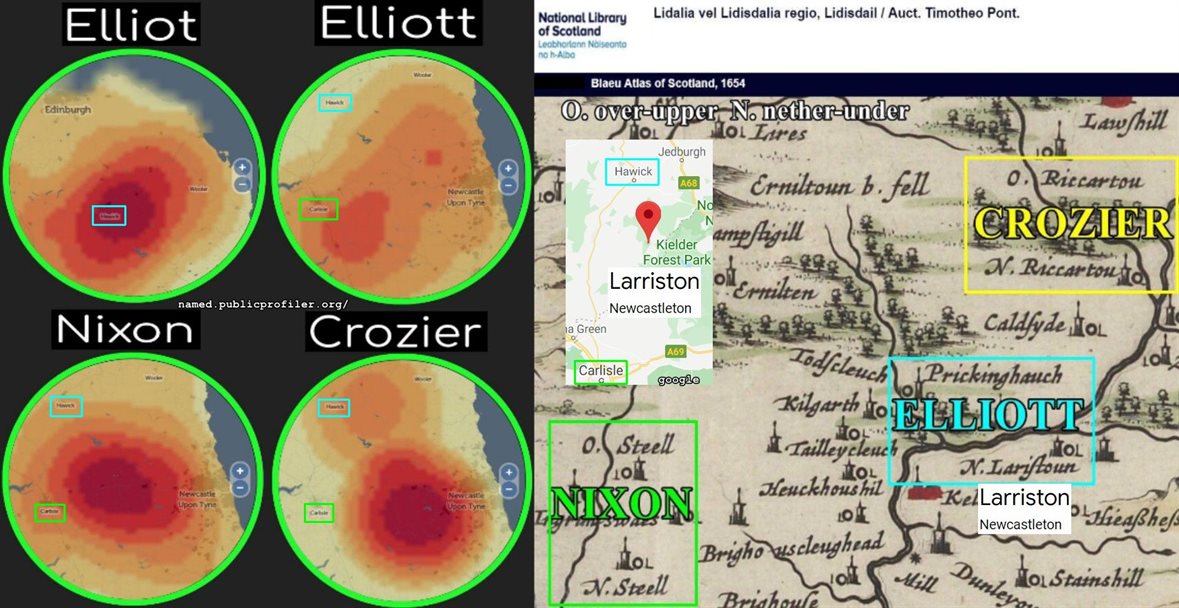
Though in the past the Elliott, Nixon, and Crozier were concentrated around Larriston on the Scottish side of the border, but today they seem to be concentrated in or near Northumberland.
Like
 Mark Elliott
Mark ElliottNovember 10 @ 9:40pm
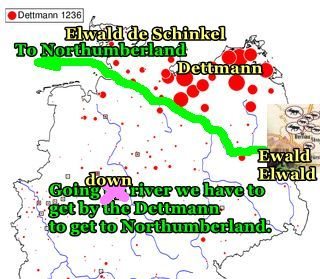
https://www.google.com/search?q=Northumberland+FTDNA&rlz=1C1AVNA_enUS566US566&sxsrf=ACYBGNQ91fpIQxIDSmn8z3UQuizaCRKi8A:1573445629303&source=lnms&tbm=isch&sa=X&ved=0ahUKEwjGgbvepeHlAhWHup4KHSljAuYQ_AUIFCgD&biw=1280&bih=612&dpr=1.5 Belinda Dettman, Take my research seriously. It is over a thousand years of migration from near Berlin, to where I live in the New Mexico Corner, of the Four Corners. Upload images to the web, they become in demand. Belinda, who do you think owns and operates https://elwald.com/ . Following in the footsteps of dad which dot matrix printed and passed out his publications. When you Google Images for ‘Northumberland FTDNA’, it seems like some of what I uploaded to the web is in demand. Don’t think you have to be concerned about my demand. A lot of people have went to and from Northumberland, and are interested in migrations in and out of it. Belinda Dettmann 6 hours ago This is the Northumberland geographic project. If your Elliotts do not come from Northumberland, or the Scottish Borders, your entries may be of less general interest.
Like
 Mark Elliott
Mark ElliottNovember 10 @ 11:34am

Considering where the Dettmann are from, taking a big chance showing a picture of my relatives to the admin. Basically, some of the older adopted names are from animals, and the Wolf is an example. Like the wolf, man is also a predator of the elk (moose). It is said that the moose are following ancient trails to get to their ancient lands in Germany east of Berlin, where the ‘wald’, German for forest is. The only thing I can figure out is that the bull/father elk/moose, retains it’s historical history down it’s Y-DNA of the fathers, and the cow/mothers elk/moose, retains it’s historical history down it’s mtDNA of the mothers. That way they can get together and produce autosomal combo calf. To get a name such as Elwald/Elliot of Proto-Germanic R-U106 Y-DNA, which refers to as ‘elk (moose) of the forest’, there has to it seems to be ‘elk (moose) in the forest’, where that surname came from. The closest German name I have been able to find near the name ‘Elwald’, is the name ‘Ewald’, and there is a concentration of the surname ‘Ewald’, where the elk (moose) are crossing over from Poland into Germany.
Like
Belinda Dettmann
November 10 @ 3:25pm
This is the Northumberland geographic project. If your Elliotts do not come from Northumberland, or the Scottish Borders, your entries may be of less general interest.
Unlike You and Nigel Douglas like this
 Mark Elliott
Mark ElliottNovember 4 @ 4:19pm
Like John Wilkinson likes this
John Wilkinson
November 4 @ 5:20pm
Thanks Mark, yes I’ve seen that graphic. A guy over on Anthrogenica has broken it down into even more discrete locale densities. Not definitive but certainly intriguing and generally supports the hypothesis.
Unlike You like this
Mark Elliott
November 4 @ 7:52pm
Kind of figured it was repeat info. Article runs a later time 1000-1100 from Viking add mix. Am figuring this is the time which my Y-DNA crossed with the I-Viking admix. James M. Irvine admin in the FTDNA Clan Irwin surname has found a strong link between I-M253 Fairbairn and Elliott, where the Fair bairn and Elliot Elwald elk (moose) of the forest of the Armstrong Chronicles. https://gorrenberry.com/wp-content/uploads/2016/05/Fairbairn-I-M253-Elliott-Viking-add-mix.png In accordance with the ‘Fair Bear’, story this is showing by Y-DNA I-M253 that the ‘Bear’ (Fairbairn), and ‘Elk’ (Elliot) are related. James M. Irvine admin to FTDNA Clan Irwin surname, has a great statement I’m finding accurate; “With a combination of diligence, intuition, peer guidance, genealogical awareness and luck rather than a sophisticated knowledge of biology or mathematics I show that 37 STR markers are often quite sufficient to identify genetic families/surname branches, and one or two SNP Panel tests can be a very cost-effective follow-up to take many testees to near the forefront of this exciting application of citizen science. James M. Irvine” https://ggi2013.blogspot.com/2017/10/james-irvine-speaker-profile.html James M. Irvine; AGREE Just found this today; Y-DNA Haplogroup R-U152 in Britain: Proposed Link to the 5th Century Migration of the Angle and Jute Tribes from Jutland and Fyn, Denmark (Hypothesis B) David K. Faux http://davidkfaux.org/Angles_England_R_U152.pdf Put my R-U106 in north Germany near Kiel., the Elwald de Schinkel.
Like John Wilkinson likes this
 John Wilkinson
John WilkinsonNovember 4 @ 2:12pm
Prompted by one of my Y67 match’s confirmation that his line traces to Denmark, and also by the fact that I know of a group of Wilkinsons in Coquetdale in Northumberland from at least the late 1300s, I decided to research the Viking history in Northumbria. I found this website which is pretty informative. https://englandsnortheast.co.uk/VikingNorthumbria.html But most interesting to me was this passage fairly early on: “For seven decades the Vikings would continue raiding the coast of Britain and it seemed inevitable that they would eventually launch a full scale invasion of our shores. This is precisely what occurred in the year 866, when a huge army of Danes invaded East Anglia from their well established bases in the Low Countries of the Continent. They arrived under the leadership of Ivar the Boneless and his brothers, Halfdene and Hubba and after camping the winter, turned their attention to Northumbria.” Two things are interesting to me as U152>L2>Z367>L20. First, obviously that these were Danish Vikings since my match traces to Denmark (I know of at least two other unrelated L20s who also trace to Denmark). Second, that they launched the invasion from strongholds in “the Low Countries”, i.e. what is now Netherlands and Belgium. This is worth noting because there are pockets of U152 that are in the 20% and higher range in these areas. In my opinion this adds to the possibility that my paternal line arrived with these Danes. Although, as previously noted by Dr. Faux in his research and analysis, if the Jutland Cimbri of the classical era were also U152>L20, then its possible we were already there as Brittonic Celts too. We know of at least two ancient Viking remains that were recently confirmed U152>L20. A Viking connection to these subclades undoubtedly exists. The question remains, are the Vikings my paternal line’s vector into the British Isles? Only additional testing will get us the answers we seek. Hopefully more of the lines who remained in the old country will test as well.
Like
 Mark Elliott
Mark ElliottOctober 23 @ 2:08pm
Like
Belinda Dettmann
October 23 @ 3:12pm
Where did you get elk of the forest from? I think that’s rubbish.
Like Nigel Douglas likes this
Mark Elliott
October 23 @ 9:16pm
https://gorrenberry.com/wp-content/uploads/2018/07/Chronicles-of-the-Armstrong.jpg https://www.findagrave.com/memorial/38734448/albert-bird-armstrong In lieu of flowers the family suggests contributions to the Armstrong surname genealogical organization. https://archive.org/details/chroniclesofarms00arms/page/n13 Latter Day Saints are raised on genealogy; https://www.familysearch.org Is of The Church of Latter Day Saints. When I met Albert Bird Armstrong in the collections of The Church of Latter Day Saints Office Building, in Salt Lake City, Utah, before 1973 and before construction of The Family History Library, he made reference to The Chronicles of the Armstrong. By Robert Bruce Armstrong of Edinburgh, Scotland. https://books.google.com/books/about/The_History_of_Liddesdale_Eskdale_Ewesda.html?id=nFr7oQEACAAJ If the Armstrong were genocide from their border homelands then those responsible for this genocide would think what they publish as rubbish. That would be quite natural. They would censor out those which support such ‘rubbish’ like an Elliott, by denying free speech on the manner. The second president of The Church of Latter Saints, Brigham Young has an Anglo-Border name and am getting a lot of support for; https://elwald.com/brigham-this-is-the-place-genealogy-with-dna-applied/ a link I built on applying DNA to Family History, of which I use my own family as an example.
Like
Gail Andrews Hardy T124143
October 24 @ 6:57am
I find your reference to Alford interesting. My line goes back: Lowell King Andrews, Willard Albert Andrews, Samuel Franklin Andrews, Ambrose Andrews and Hannah Phelps, Jacob Phelps, Jacob Phelps and Abigail Alvord, Benedict Alford, Jeremiah Alford, Benedict Alford, Thomas Alford, William Alford, Alexander Alford, John Alford, Thomas Alford, John Alford (1430 in Somerset, England).
Like
 Mark Elliott
Mark ElliottOctober 23 @ 2:08pm

https://archive.org/details/chroniclesofarms00arms/page/n13 https://named.publicprofiler.org/ “DNA Testing, The Armsrongs are not related to the Fairbairns. This is according to Lorna Henderson. Someday we will have our own clan, without being part of the Armstrong clan.” https://www.genealogy.com/forum/surnames/topics/fairbairn/499/ Armystand (1376 army strand on Scottish side of Liddel), Armestrang (Scottish for army strong), then after border pacification Armstrong. Recognized by the Bruce, and Douglas, as being The Strong Army of Scotland. When relatives where on both thrones of both kingdoms, that of England and Scotland, Armstrong genocide began, with a policy of exterminating those with the surname Armstrong, and its ‘army strong’ variants. https://gorrenberry.com/wp-content/uploads/2019/02/Scottish-Clans-Armstrong-BBC-Stewart-kings.mp4 (Anna Groundwater commentary less than a half minute long) The Scottish Middle March, 1573-1625: Power, Kinship, Allegiance https://books.google.com › books Anna Groundwater – 2010 FOUND INSIDE – PAGE 23 “Power, Kinship, Allegiance Anna Groundwater … the Middle March’s geographical location on the frontier between two periodically hostile kingdoms affected its political, administrative, social, … England and Scotland, 1100–1300′,..”
Like
 Mark Elliott
Mark ElliottOctober 20 @ 4:31pm
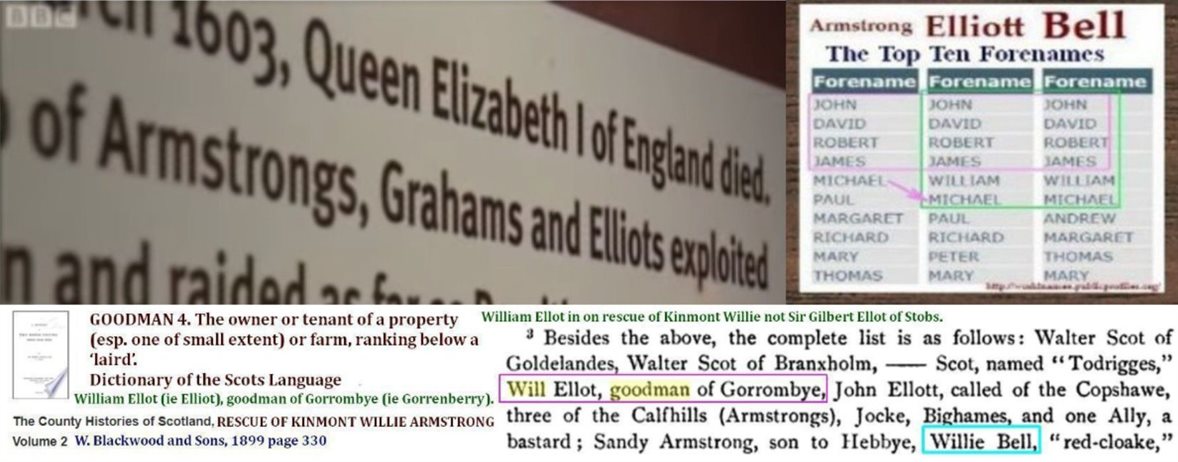
Armstrong, Scott, Elliott (Gorrenberry and Copshaw, not Stobs), Bell, and Graham were in on the rescue of Kinmont Willie Armstrong from Carlisle Castle. http://clangrahamsociety.org/files/BorderGrahams&Rossadown.pdf https://www.historyireland.com/early-modern-history-1500-1700/sheep-stealers-from-the-north-of-england-the-riding-clans-in-ulster-by-robert-bell/ Ballads of the Border Reivers. https://www.youtube.com/watch?v=BydA73Isw_U https://gorrenberry.com/wp-content/uploads/2018/12/HISTORY-HUNTERS-Kinmont-Willie-Armstrong.mp4 https://gorrenberry.com/ballad-kinmont-willie/ Among the first four surnames do not know which one was the worst. “Armstrong, Elliot, Graham, Irvine,…” What’s in a Name? Allegiance, for Border Reivers By GRAHAM HEATHCOTE FEB. 11, 1996 12 AM ASSOCIATED PRESS CARLISLE, England — Ever suspected that your ancestors were robbers who terrorized the border between England and Scotland? Armstrong, Elliot, Graham, Irvine, Johnstone, Kerr, Maxwell, Nixon and Scott were among the families who rode, feuded, fought and plundered over the border area for 350 years. All the family names of the Border Reivers, whose first allegiance was to their family’s surname, are on a list kept in Carlisle, on the English side of the border. From the 14th to the 17th centuries, the border was a turbulent place. Raiders stole cattle and women, burned homes and farms and killed rivals without mercy. From surviving documents such as court and property records and tenure agreements, researchers have identified 74 family names from that region in the 16th and 17th centuries. Some names have changed over the years: Johnstone becoming Johnson, for example. Reive, meaning to plunder or rob, comes from the dialect of the Scottish Lowlands and borders. “The folk memory of the Reivers has passed away, but their stories survive in the border ballads,” said David Clarke, senior curator of Tullie House Museum. “We have music about them and [the novelist Sir Walter] Scott collected a lot about them and put them into his novels.” The museum has made an audio-visual show about Reivers the centerpiece of a $7.5-million restoration. The bell that rang to warn Carlisle townspeople of raids is in the museum. Images of galloping horse riders, lookouts, panic-stricken settlers and torched homes and forts are projected on a 30-foot screen. Voices intone the fear of women waiting for raids: “The Reivers are riding to take what we stole from them that had been ours before.” The border with Scotland is nine miles north of Carlisle, but in Reiver times it wasn’t so definite. “North of Carlisle were the debatable lands, territory which was declared to belong to neither Scotland nor England,” Clarke said. “The Reivers operated on both sides of the border. “It was peat moss and bog country, a huge tract of wet and desolate moorland at the head of the Solway Firth,” he said. “You had to know your way around it or you would have got lost and died. Nowadays it’s mostly quarried for peat or drained for farming. “Carlisle is a border city and changed hands between the English and Scots several times in the Middle Ages, so the museum took up the Reivers as a very interesting episode,” he said. “It’s become one of our main attractions.” Clarke said the Reiver story is still little known despite George MacDonald Fraser’s novel, “The Steel Bonnets.” Fraser was astonished by the Reiver connections he saw in a photograph of Presidents Lyndon B. Johnson and Richard Nixon and evangelist Billy Graham together at Nixon’s inauguration. Johnson’s visage and figure were straight from Dumfriesshire, where everyone was familiar with such lined and leathery faces, large heads and rangy, rather loose-jointed frames, Fraser said. The Graham features were less common but still familiar, while Nixon was the perfect example of the Anglo-Scottish frontier: blunt, heavy features, dark complexion, burly body and an air of dour hardness. Fraser said all three heads would fit perfectly under a steel bonnet. “The Reivers were thieves, but warriors as well, and without allegiance to anyone outside their clan. Any English or Scottish king going to war here needed the Reivers on his side,” said Chris Dobson, a Carlisle city official. He said the Reivers were eventually repressed, deported, killed or compelled to emigrate under threat of imprisonment and that many ended up in Ireland. Haydn Charlsworth specializes in researching family histories around Carlisle and has traced Reiver connections for American clients. “Once you get back to the 16th century, it’s pretty difficult to make strong links, but the Armstrongs are well documented, and the Johnstones,” Charlsworth said. https://archive.org/details/chroniclesofarms00arms/page/n13 https://books.google.com/books/about/The_History_of_Liddesdale_Eskdale_Ewesda.html?id=nFr7oQEACAAJ https://gorrenberry.com/wp-content/uploads/2019/08/Clan-Johnston.mp4 https://gorrenberry.com/wp-content/uploads/2019/07/Maguire-Armstrong-Elliott-Johnston-Fermanagh-surname-distribution-map-1.jpg Armstrong and Maguire marrying of Ulster Plantation, County Fermanagh, Ireland. https://d3tije9h5o4l4c.cloudfront.net/social-photos/3296539?dpr=2&fit=max&h=856&w=590 I Remain Unvanquished!: The Incredible 1,000-year History of the Armstrong Family by William Stephenson publisher; Great Northern Pulp & Paper Group Limited, 1989 – Canada – 183 pages “Men who carried arms were liable to be called up by the sheriff so there are records of them.” Visitors can get a “Reivers Car Trail” leaflet in Carlisle to guide them through 80 miles of Reiver country. It describes one of the most unspoiled and splendid parts of Britain as it was in 1590, just after the defeat of the Spanish Armada. Towers, churches and castles are still there, though often only as ruins, and so are banks and ditches, remnants of Roman forts built more than 1,200 years before when nearby Hadrian’s Wall was the northernmost frontier of the Roman Empire. Reivers by Name The 74 family names in surviving documents about the Border Reivers: Archbold, Armstrong, Beattie, Bell, Burns, Carleton, Carlisle, Carnaby, Carrs, Carruthers, Chamberlain, Charlton, Charleton, Collingwood, Crisp, Croser, Crozier, Cuthbert, Dacre, Davison, Dixon, Dodd, Douglas, Dunne, Elliot, Fenwick, Forster, Graham, Gray, Hall, Hedley, Henderson, Heron, Hetherington, Hume, Irvine, Irving, Johnstone (Johnson), Kerr,Laidlaw, Little, Lowther, Maxwell, Milburn, Musgrove, Nixon, Noble,Ogle, Oliver,Potts, Pringle,Radcliffe, Reade, Ridley, Robson, Routledge, Rutherford,Salkeld, Scott, Selby, Shaftoe, Simpson, Storey, Tailor, Tait, Taylor, Trotter, Turnbull, Wake, Watson, Wilson, Woodrington, Yarrow, Young Associated Press https://www.latimes.com/archives/la-xpm-1996-02-11-mn-34692-story.html
Like
Gail Andrews Hardy T124143
October 20 @ 6:40pm
I have Armstrongs from Durham, England, and from Ireland; Bells from Edinburgh and Fife; Carleton from Lincolnshire; Carnabys from Halton Castle and Northumberland; Carrs from Yorkshire; Carruthers from Dumfries-shire; Chamberlain from Wessex and Wexford; Charltons from Apley Castle in Shropshire, Cambridgeshire, and Cheshire; Charleton from Shropshire; Crisp from Surrey; Crozier from Surrey and Bedfordshire; Cuthbert from Ayrshire; Dacre from Naworth Castle in Cumberland, Northumberland, Norfolk, Yorkshire, Lancashire, Herefordshire, and Sussex; I think I’ve got most of them.
Unlike You like this
Mark Elliott
October 20 @ 7:01pm
Armstrong, Bell, Carr, and Crozier, has strong linking to Elliott. Looking from the English side of the border easier to spot. Families are of the border region, when the border is identified it puts them on both sides. Can utilized ‘hot spot’ locality software to see how well it identifies localities. https://named.publicprofiler.org/ Area you describe the Curruther at https://elwald.com/carruthers-i-m253-y-dna/, most are I-M253 Y-DNA. For Crozier which lived near the Larriston Elliot at Ricarton http://clancrozier.com/ Descended from a most notorious border reiver; Clementis Hobs (ie Clement Crozier’s sister’s son Robert Elliott). https://gorrenberry.com/wp-content/uploads/2015/01/Clemementis-Hob-hand.jpg https://gorrenberry.com/wp-content/uploads/2015/01/Clementis-Hob-William-Douglas-Cavers-Gledstanes-Coklaw1.jpg https://gorrenberry.com/wp-content/uploads/2019/09/Crosar-of-Stobs-and-Agerstoneshields.png http://clancrozier.com/wp-content/uploads/2018/12/Nixon-with-Crozier-Elliott.jpg https://gorrenberry.com/wp-content/uploads/2019/01/Karruthers-Carruthers.png Go way back with the Armstrong https://gorrenberry.com/rich-rucker-clan-armstrong-dna-question/ Basically you have Anglican-Borderers. Did not relate well to kingdom, but better to border families. Need to behave yourself on this site, if you do not they may send you to Liddesdale like https://elwald.com/hobbie-noble/ Hobbie Noble, to live among those notorious Armstrong, Elliott, Nixon, and Crozier of the Scottish Middle March.
Like
Gail Andrews Hardy T124143
October 21 @ 5:55am
Mark, if you had a map of Scotland with all the clans listed on it, I could throw a dart at it blindfolded and hit a clan that I’m related to. However, it was kind of thrilling when I went to Scotland in 2005, I’m in Dumfries and Galloway riding in a “King” bus (my father’s mother was a King, though her line was from Ireland when a truck bearing the Armstrong name (my dad was born in Armstrong, Illinois) came tootling down the road. I figured I was in a “friendly” neighborhood.
Like
 Mark Elliott
Mark Elliott John Wilkinson
John WilkinsonOctober 8 @ 7:59am
If anyone on here is in Northumberland and knows any Wilkinsons in Northumberland, please pass my email jcmaxwilkinson@gmail.com on to them. I know there were Wilkinsons in Coquetdale at least as of late 1300s. I was reading through Northumbrian history and was interested to learn that for a time Northumbria extended all the way north into Lothian and included Edinburgh. Lothian would have been part of the Celtic Old North prior to that. My one non-family Wilkinson match (Y37, all the further he tested) traces to East Lothian. He’s not refined his haplogroup past M269, so I don’t know if he’s also U152>L20. Assuming that he is, and assuming our lines converge in Lothian somewhere before 1700, the question becomes were we pre-Anglo Saxon Celts (U152 presumably implies that, presumably La Tene Votadini tribe assuming the line remained in that region) or were we an uncommon U152 Anglo Saxon (or later Dane) line? There were Wilkinsons in the Border counties and Lothians in Scotland at least as of the 1500s too. Did they migrate from Northumbria or vice versa? Hopefully further research and maybe some ancient DNA will eventually solve the mystery.
Like Nigel Douglas likes this
 Mark Elliott
Mark ElliottSeptember 24 @ 8:02pm
Like
 Mark Elliott
Mark ElliottSeptember 23 @ 3:51pm

FTDNA 12 marker matches “The main place that you will see matches with many different surnames is the Y-DNA12 Marker Matches section. The time to a common ancestor for these matches may extend beyond genealogical records and the adoption of surnames.” https://www.familytreedna.com/learn/user-guide/y-dna-myftdna/y-matches-page/ LINQUISTICS ‘becc’ – Bosworth–Toller Anglo-Saxon Dictionary bosworth.ff.cuni.cz › … a beck, brook. v. bec. … becc. Morphological Analysis. Wordclass: Noun. Gender: Masculine, Feminine, Neuter. This might be a link to, a part of or a variant of … ARCHAEOLOGY a brook? It is moated with records going to c1250 https://en.wikipedia.org/wiki/Beck_Hall GRESHAM Norfolk ‘ham’ home is definitely a place name also ‘moated’ at Gresham Castle goes back to c1250. https://www.familytreedna.com/groups/gresham-grissom/dna-results Major matches with a major place locality of Gresham Castle. North and South Cave along with Scorborough, borough from ‘burgh’ as properly pronounced in Edinburgh means a ‘fortress on a mound’. Lindbergh, means lind (found in Beowulf) trees on a hill, place name also. https://www.familytreedna.com/public/CaveFamilyHistorySocietyDNA?iframe=yresults https://www.familytreedna.com/public/scarborough?iframe=yresults Definitely at time of place name adoption, which would be about eight centuries ago, integrating Y-DNA. Is FTDNA not a viable way to find family history. Today it is not because though FTDNA may say words, they do not support people which go by their words, and numbers distribution. To me this is a corporation due to fail, if they do not go by what they say, and delete people from blogs which are using their information and number to find genealogically the line of their father’s father. People at Brigham (BYU Brigham Young University), know genealogy because Latter Day Saints, Mormons grew up with it like I did as a second generation genealogist. This link which I created; https://elwald.com/brigham-this-is-the-place-genealogy-with-dna-applied/ They are hitting on because; Brigham ‘This is the Place’ genealogy with DNA applied .. Bing search ‘Brigham DNA’ https://www.bing.com/search?q=brigham+dna&form=PRUSEN&pc=UE07&mkt=en-us&httpsmsn=1&refig=375ed58e96834bf08f411056b9205e72&sp=-1&ghc=1&pq=brigham+dna&sc=8-11&qs=n&sk=&cvid=375ed58e96834bf08f411056b9205e72 When someone is trying to help you, which has a strong knowledge base, to kick them out can easily become self destructive. Am myself applying my findings on how to utilize and integrate Y-DNA into genealogy, and other experience family historians are gaining value from my research, it is those which believe in those admins which kicked me off their blogs which are loosing out.
Like
Gail Andrews Hardy T124143
September 24 @ 7:56am
My 12th great grandfather, James Gresham (1512-1526) came from Norfolk, England through his son Paul Gresham (1530- ? ) from Rutland, England.
Unlike You like this
Mark Elliott
September 24 @ 9:08am
Since only about one sixth of those tested by FTDNA with the Gresham surname do not match my first twelve markers, it is most likely especially being from Norfolk that your ancestor matched my first twelve markers as far as the Y-DNA is concerned. https://www.familytreedna.com/public/Gresham_Grissom?iframe=yresults, and his surname came from a place in Norfolk called Gresham, where there is a moated castle https://en.wikipedia.org/wiki/Gresham_Castle of about the early fourteenth century called Gresham Castle. Bec/Becc/Beck (Anglo-Saxon for ‘brook’) is nearby, also from that era and is moated. https://en.wikipedia.org/wiki/Beck_Hall “An early resident of Bec was Alanus Elfwold (1248).[5]” (my many great)
Like
Belinda Dettmann
September 24 @ 3:14pm
Forget about 12-marker matches if those people do not match you at higher levels. A 12-marker match on its own just means you are related about 3000 years ago, or more.
Unlike You like this
Mark Elliott
September 24 @ 4:46pm
https://www.familytreedna.com/faq-markers.aspx 12/12 29 times 30 years a generation is 870 years. 2020-870=1230, at the time of the Elwald Elliot of East Anglia. https://en.wikipedia.org/wiki/Beck_Hall https://gorrenberry.com/wp-content/uploads/2015/05/Norfolk-Suffolk-1.png In accordance to FTDNA web site. Why do I match men with different surnames? https://www.familytreedna.com/learn/user-guide/y-dna-myftdna/y-matches-page/ …. “The main place that you will see matches with many different surnames is the Y-DNA12 Marker Matches section. The time to a common ancestor for these matches may extend beyond genealogical records and the adoption of surnames.” With stating related beyond adoption of surnames, plus; Gresham, Norfolk, North and South Cave, and ‘de Scorborough’ likely evolving into Scarborough, an showing numerous matches with more then half the ones test with those surnames, and FTDNA showing graphically that at 29 generations https://www.familytreedna.com/images/probabilities.gif at 95%, which the chief is vikings carrying my R-U106 Y-DNA recorded at 29 generations, plus recorded history of the Chronicles of the Armstrong https://archive.org/details/chroniclesofarms00arms/page/n13 of the Elwald Elliot of Crowland-Croyland, of the Fenlands. With largest percent of matches leaning towards Gresham, and -ham meaning home and home is the place, and Elwald later found in Cottingham and York in the fifteenth, century, and Robert Elwald chieftain 10 https://upload.wikimedia.org/wikipedia/en/4/43/Sasine_deed_1484_for_Robert_Elwald_%28Elliot%29%2C_Redheugh%2C_Larriston%2C_Hartsgarth.jpg receiving lands of Redheugh and Larriston, with the 29th chief living on Redheugh lands, this is certainly if Y-DNA is ever valid to be utilized as a tool, and not a product of destruction by those FTDNA which have published the given standards which my premises are based on just to try to usurp my family in line Y-DNA findings will show that utilizing FTDNA Y-DNA as a source for genealogy, does not have validity except in the course of corporate profit making. If info given by FTDNA is not correct than how can someone get correct results by testing with FTDNA? If it is not most definite by standards of genealogy, linguistics, archaeology, and genetic DNA that my Y-DNA came in from the North Sea, as Proto-Germanic R-U106, then this shows the level on knowledge FAMILY TREE has on the genealogical genetics of a Y-DNA member of the family migrating ones own DNA.
Like
 Mark Elliott
Mark ElliottSeptember 23 @ 9:10pm

Am related to Carl Finch. Match him exactly in twenty-five markers. The names you find are Finn, Finnie, Finrock, and Finch. The Finch is from Fitzherbert, it is likely that the names began from the region of Fenlands referred to as the Fenns, many islands, drained in 1650 at the time of Cromwell. So Fenns became the surname Finn, which became in some cases Finch, Finnie, and may be with question Finrock, and the Chronicles of the Armstrong have the Elwald -Elliot, located at Crowland (Croyland) of the Fenns. https://archive.org/details/chroniclesofarms00arms/page/n13
Like
Gail Andrews Hardy T124143
September 24 @ 7:15am
Finn also has strong ties to Ireland.
Unlike You like this
Mark Elliott
September 24 @ 11:39am
Frequency of the surname ‘Finn’, is much much higher in Ireland than England. In 2014 England 1:6,620 as opposed to Ireland 1:850. https://forebears.io/surnames/finn In Irish ‘finn’ means ‘me’, in Scots Gaelic ‘we are’. Likely independent surname development then that of being from the East Anglia ‘Fenns’.
Like
Gail Andrews Hardy T124143
September 24 @ 2:50pm
In Ireland it can also refer to people believed to be descended from Finn McCool.
Unlike You like this
 Mark Elliott
Mark ElliottSeptember 24 @ 9:40am
It is time for families to get back together again, which have been separated by border pacification. These families should first include Dukes of; Northumberland, Buccleuch, and Roxburghe ‘Ker’, along with a brother family Ferniehirst ‘Kerr’. Families displaced around the world want to return to their ancestral homelands to find a sense of self. Need a Borders Peace Park to protect the home place of Clan Elliott, The Hermitage Castle from industrial destruction. https://www.telegraph.co.uk/news/earth/energy/windpower/8713199/Duke-of-Northumberland-an-unlikely-hero-in-the-fight-against-wind-farms.html
Like
 Mark Elliott
Mark ElliottSeptember 23 @ 12:55pm

https://www.rootstech.org/video/you-can-do-dna John Wilkinson 20 minutes ago “Thanks Mark. I know how to name search FF matches. I was just wondering if there are any known autosomal markers identified in recent study that could be searched for in individual FTDNA results, regardless of surname, they may be there but I cant find them.” How family members are being successful at family history; 1.The family knows best. 2.Listen to others, especially of the opposite sex, to make family. 3.Do not in a family search, get rid of the in-laws (Xs), though you may want to. 4.Families fight, and likely not just one answer is correct, in the history. 5.If the family’s history is done properly one does not get to pick their ancestors. The ladies presented themselves at Roots Tech in Salt Lake City, Utah in 2015. In 2020 it is in Salt Lake City, Utah; https://www.rootstech.org/salt-lake FTDNA is not as oriented as these ladies being Latter Day Saints, going to Brigham Young University. Do not tell those Mormons this but Brigham Young is an Anglo-Scottish Borderer name. One does not put the cart ahead of the horse, meaning the genealogy comes first like in the many established autosomal sites, like ‘the guide team’, and in genealogy; YOU CAN DO DNA, it is not rocket science. FTDNA have to realize that their SNP subclades are beginning to reach into genealogical time for some researchers, which are going back far in time with their Y-DNA. The prehistoric does not cut it for genealogy, of the ‘so called’ DNA experts, the ones which share family knowledge with families, then applying DNA, are circumventing these DNA ‘experts’. Until they realize the first statement ‘family knows best’, they will never be able to do family history-genealogy. The Guide Team started with family history-genealogy, the family, and are now putting the genetics to it. FTDNA can destroy their own future, even though the numbers are there to integrate them into family history, when family history is being done they allow their felt to be ‘superior’ knowledge base supersede and smother the family history which is being developed, not becoming integrated into that which has properly been successful in finding history of families for centuries. Been for my own family able to integrate FTDNA Y-DNA, with place names, and census surname concentrations of Y-DNA quite successfully. Some FTDNA blogs have excluded me from doing so. The guide team which has done the Roots Tech video in 2015, going cross corporate, and showing advantages among the different autosomal corporations, have done it quite successfully. If FTDNA drops the prehistoric, and the superseding of family information, but integrates their Y-DNA test into the family data base it is felt going downstream, but a cluster not testing a “Big-Y”, but just testing the SNPs which are in time reaching further into genealogical time I feel they will be much more successful with family genealogists using Y-DNA. Roots Tech 2020 is again in Salt Lake City, Utah; https://www.rootstech.org/salt-lake
Like John Wilkinson likes this
Belinda Dettmann
September 23 @ 3:15pm
It is true that Y-DNA tests like BigY are beginning to find SNPs that occurred in genealogical time, but in general there is very little help within the Y-Line from Family Finder matches if the relationship is beyond fourth cousin, or 5 generations.
Unlike You like this
Gail Andrews Hardy T124143
September 24 @ 8:07am
To do proper genealogy, you need all the different DNA types as well as the paper trails to verify it. Yes, DNA is a foundation, but if all you know is your surname and you get back 500 years, you could have a couple thousand people with your surname to which you are related, but which one is your direct ancestor? That is where the paper trail comes in. I have found people who were 5th to remote cousins with Family Finder, and I have multiple connections with them. The record so far is 13 separate connections ranging from 7th great grandparents to 23rd great grandparents. All FF said was that we were related.
Unlike You like this
 Mark Elliott
Mark ElliottSeptember 23 @ 9:33pm
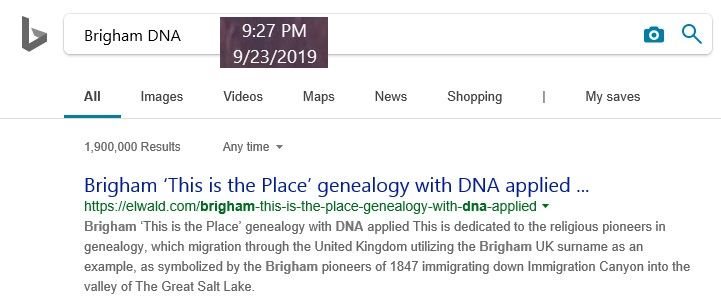
To have a link I built come to the very top of 1.9 million results in a Bing search of ‘Brigham DNA’. If the Brigham (BYU) DNA people are hitting that link, what does it say about someone which doesn’t, are they really a family research genealogist? Yes, FTDNA Y-DNA is quite useful in the hands of a genealogist, integrated with other tools which they have developed, but not to the ones which kick people off their blogs for doing family history.
Like
 Mark Elliott
Mark ElliottSeptember 23 @ 9:17pm

Daniel Cluster, a Y-DNA branch point for Daniel Elliot which left testimony Salem Trials, 28 Mar 1692. With SNP testing the others are on the first son, and I am of the sixth son. The Brigham people are all ready on to this one. If on familysearch.org; https://www.familysearch.org/ark:/61903/3:1:3QS7-8979-6QBV?i=22&cc=2061550&cat=74325 Today Y-DNA is quite useful in genealogy, but in order to do genealogy one must share, and not refer to one as a liar and kicking that one out of FTDNA blogs.
Like
 Mark Elliott
Mark ElliottSeptember 23 @ 8:43pm
Genealogy is sharing of family history, and from my perspective it seems like the ones without the Y-DNA are better at doing this. Because the ones with the Y-DNA, try to supersede, I beginning to feel like I am stuck with a pot of gold I am trying to share but sometimes no one wants it. Thought their is this Lucio Gomes from Brazil, using an English translator, to translate from Portuguese to be in the English FTDNA blogs. Has indigenous South American blood in him. You will find that he has been in the Dunbar activity feed with a cowboy admin near Dallas. This is part what we came up with; https://gorrenberry.com/wp-content/uploads/2017/10/Dunbar-1024×533.jpg Both our families fought against Cromwell, his at The Battle of Dunbar, and ended up in Brazil, and mine in the Battle of Worcester and ended up in Massachusetts Colony ‘transported as Scottish POW slaves’. Dunbar has been through many battles, therefore the surname Dubar is dispersed, the Cockburn, adopting their surname from the same Y-DNA pool are not dispersed like the Dunbar, because they did not go through the battles the Dunbar did. This is just one small example of the use of Y-DNA.
Like
 Mark Elliott
Mark ElliottSeptember 23 @ 6:51pm

https://www.youtube.com/watch?v=6ANNHMzmxlI https://www.cambridge.org/core/journals/antiquity/article/people-of-the-british-isles-project-and-viking-settlement-in-england/54E19CAFF9AC2BEB39EAEC826BEDBC63 In 1977, the Elliot Clan Society was formed by the Clan’s late hereditary Chief, Sir Arthur Eliott, 11th Baronet of Stobs and Laird of Redheugh, the ancient seat of the Clan Chiefs.Our present Chief is Sir Arthur’s daughter, Margaret Eliott of Redheugh, the 29th Elliot Clan Chief. The primary purposes of this Society, which is headquartered in Redheugh, are to preserve the history and traditions of the Clan, and to promote a spirit of kinship among its members. In the words of Sir Arthur, “the tie is essentially a family one, transcending national boundaries and disregarding distinctions of age, sex, wealth or status. Thus our Clan Society is more than a club and more even than what is generally understood by a ‘Society’. It is above all, a family association and has been formed for those of us who feel that this ancient tie is of special interest and value to our modern world.” https://www.elliotclan.com/history/ https://elwald.com/clan-elliot-29th-chief-margaret-eliott-of-redhuegh-stobs/ Takes a lot of research to go 29 generations down my Y-DNA. At 29 generations markers 12/12, 25/25, and 37/37 all rang the same, and goes to when the Elwald-Eliott chieftain began, and around the last time the Vikings came into England. https://gorrenberry.com/wp-content/uploads/2017/02/Proto-Germanic-U106-M223-M253.jpg
Like
 Mark Elliott
Mark ElliottSeptember 22 @ 4:54pm
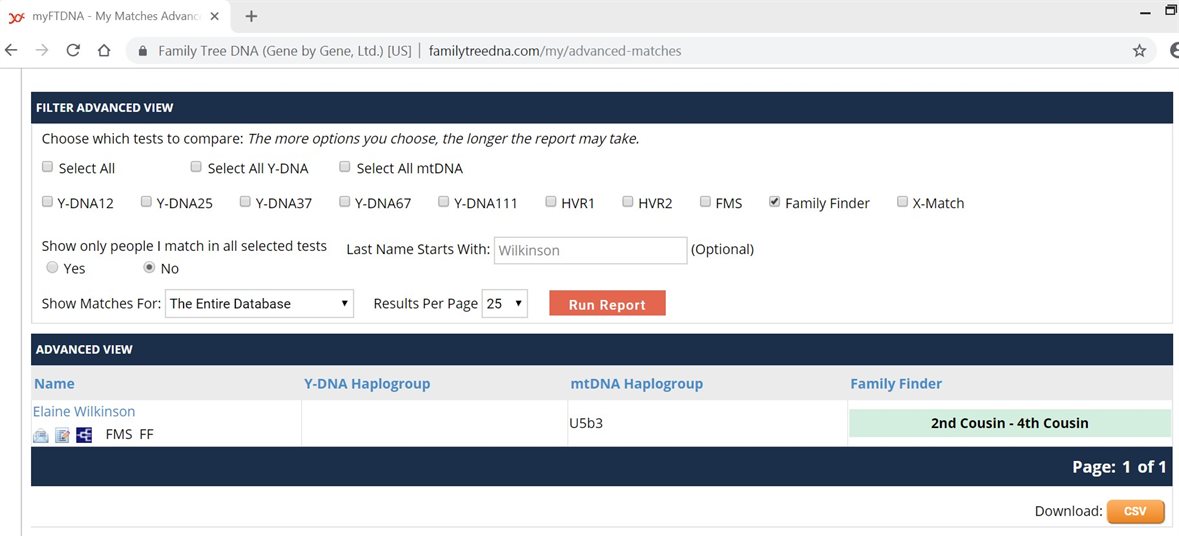
John, ” I’ve done Family Finder too so my autosomal is in FTDNA dbase.” The shorter the number of letters the better, as long as it comes down to one page. Like for Wilkinson, W, Wi, or then Wil. Gail Andrews Hardy T124143 19 hours ago I’ve got Elliot and Elliott from Ireland, Scotland and England. John Wilkinson 3 hours ago Mark, I’ve done Family Finder too so my autosomal is in FTDNA dbase. Is there any way a person compare their personal autosomal to the regional autosomals in this study? Triangulation? Just trying to figure out if this can be leveraged as a means of narrowing the footprint of where to look for leads in general, which might help narrow focus on the Y line too. John, Advance matches has quite a bit but does not seem what you are asking for. Gail Andrews Hardy T124143, and I A269034 also utilize a free service called gedmatch.com.
Like John Wilkinson likes this
John Wilkinson
September 23 @ 12:22pm
Thanks Mark. I know how to name search FF matches. I was just wondering if there are any known autosomal markers identified in recent study that could be searched for in individual FTDNA results, regardless of surname, they may be there but I cant find them.
Like
 Mark Elliott
Mark ElliottSeptember 19 @ 7:03pm

https://www.libraryireland.com/gregg/gregg-volume.pdf https://www.peopleofthebritishisles.org/ DIAHAN SOUTHARD APRIL 2, 2015 DNA Reveals UK Genetic Roots https://www.yourdnaguide.com/ydgblog/2018/10/19/ancestor-reconstruction A new DNA study details the origins of UK residents of European ancestry. Here’s why this matters to your genetic genealogy (even if that’s not your heritage). Note; The Scottish-English border, cuts across Northumberland families an their Northumberland autosomal DNA in the PoBI People of the British Isles UK rationalized study. Garrett Hellenthal – The Genetic History of the United Kingdom: the POBI project 43:02 https://youtu.be/6ANNHMzmxlI
Like
2 Comments
Gail Andrews Hardy T124143
September 21 @ 6:06am
I saw this the other day and mentioned it on another site. Any site that focuses on the British Isles will benefit from this study.
Unlike You like this
Mark Elliott
September 21 @ 8:22am
https://gorrenberry.com/wp-content/uploads/2019/07/Maguire-Armstrong-Elliott-Johnston-Fermanagh-surname-distribution-map-1.jpg Tell where the Scots border names of Johnston(e), Armstrong, and Ellio(t) went to. https://historyireland.com/early-modern-history-1500-1700/sheep-stealers-from-the-north-of-england-the-riding-clans-in-ulster-by-robert-bell/ Since Andrew alias ‘Dand’ Ellot (IE Co, Fermanagh, Ulster Plantation, Daniel Elliott) of The Borders which included Liddesdale, and Northumberland, was exiled from both kingdoms in 1607, I am more from Northumberland/Liddesdale a Borderer, then either of the kingdoms.
Like
Gail Andrews Hardy T124143
September 21 @ 9:45pm
I’ve got Elliot and Elliott from Ireland, Scotland and England.
Like
John Wilkinson
September 22 @ 1:33pm
Mark, I’ve done Family Finder too so my autosomal is in FTDNA dbase. Is there any way a person compare their personal autosomal to the regional autosomals in this study? Triangulation? Just trying to figure out if this can be leveraged as a means of narrowing the footprint of where to look for leads in general, which might help narrow focus on the Y line too.
Like
 Mark Elliott
Mark ElliottSeptember 21 @ 10:33am

Redheugh and Larriston, are lands given to Robert Elwald 10, by Archibald ‘Bell the Cat’ Douglas 5th Earl of Angus referred to as ‘Angus’, in the later part of the 15th Century. https://upload.wikimedia.org/wikipedia/en/4/43/Sasine_deed_1484_for_Robert_Elwald_%28Elliot%29%2C_Redheugh%2C_Larriston%2C_Hartsgarth.jpg https://dsl.ac.uk/entry/dost/stell_n_1 Transcribed by Teena http://freepages.rootsweb.com/~cotyroneireland/genealogy/muster/tullyhogue1610.html Cathy Carley, Having difficulty with the surname mainly spelled “Steele” which varied little over time, putting it with the Saxon name in my line ‘Elwald’, in the Cottingham-York, “ONorthumb. stelle (once, 1099-1128),” East Riding, Yorkshire region. Finding in this group; “Michael STELL, b. 1530, d. 9 Feb 1589 England” where ‘Stell’, is more like the ‘Stelle’, spelling of Germany, though the name ‘Steele’, has similarities to it. On the English side of the Border it seems though the name ‘Steele’ is prevalent that it is spelled also ‘Steele’. There are a number of Germans carrying the Y-DNA, so it is felt that the word ‘stelle’, which produced the names ‘Steele’, ‘Stell’, ‘Steel’, migrated with the Anglo-Saxons, to Anglia, Yorkshire, the Scottish Borders, onto Ulster then The Colonies with the Border Elwald-Ellott. It is basically felt to mean a place name, meaning a narrowing in a stream or river, where, fish can be trapped.
Like
 Mark Elliott
Mark ElliottSeptember 20 @ 10:12am
Like
 Mark Elliott
Mark ElliottSeptember 20 @ 6:22am
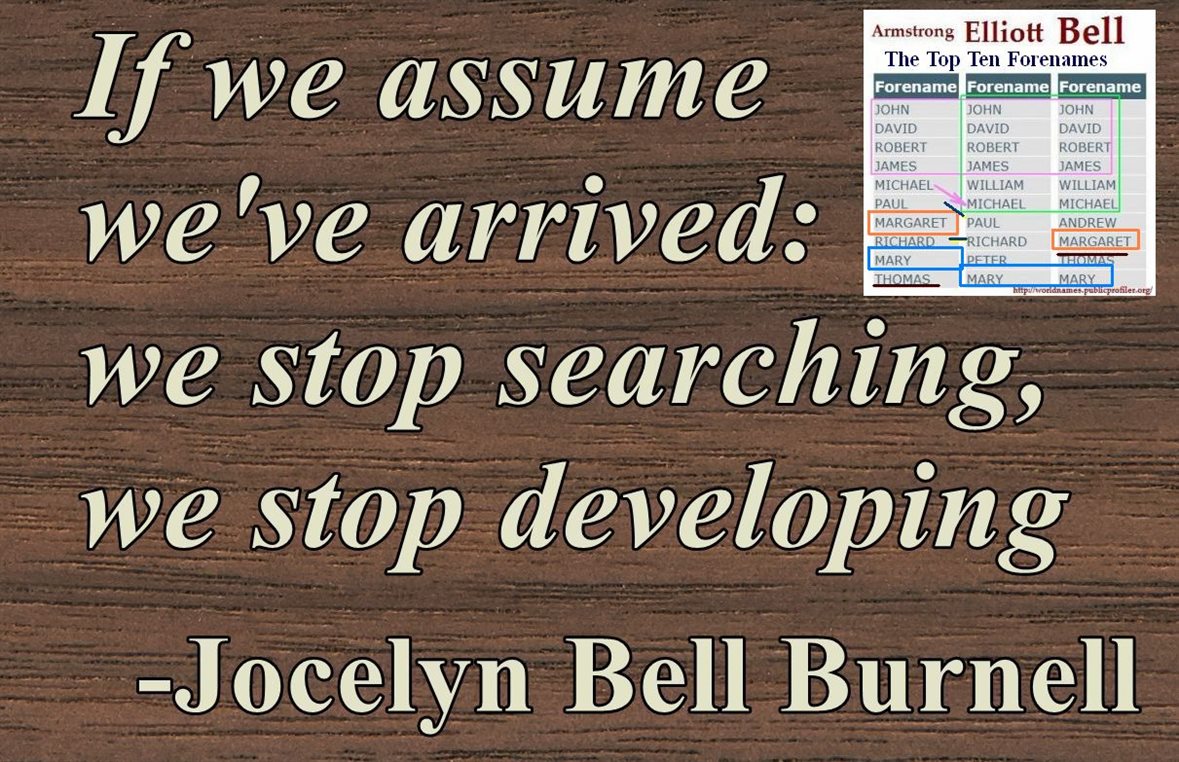
Like
 Mark Elliott
Mark ElliottSeptember 20 @ 6:20am
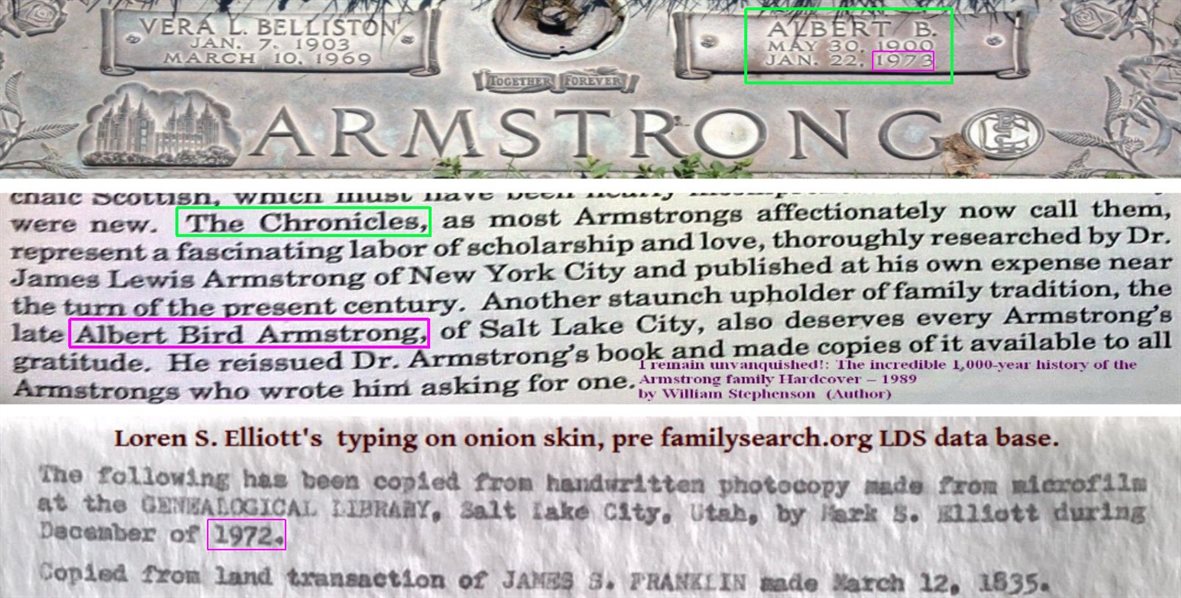
Dedication this to and Albert Bird Armstrong, who volunteered his time in dedication of Armstrong, in the upper floors of The Church of Latter Day Saints offices, where the genealogical library was kept. This dedicated to a top genealogists which want to offer their belief to their ancestors, but Albert Bird Armstrong did not bring attention to the Book of Mormon, but to a more important book to me which has my Elwald genealogical line in it; THE CHRONICLES OF THE ARMSTRONG, ed by James Lewis Armstrong MD, and made it available to all Armstrong which wanted a copy. Chronicles of the Armstrongs; by Armstrong, James Lewis 1902 https://archive.org/details/chroniclesofarms00arms/page/n13 Albert Bird Armstrong, Jr BIRTH 30 May 1900 DEATH 22 Jan 1973 (aged 72) https://www.findagrave.com/memorial/38734448/albert-bird-armstrong BURIAL Redwood Memorial Cemetery West Jordan, Salt Lake County, Utah, USA ARMSTRONG – Funeral services for Albert Bird Armstrong Jr…. In lieu of flowers the family suggests contributions to the Armstrong surname genealogical organization. Funeral directors, Deseret Mortuary.
Like
 Mark Elliott
Mark ElliottSeptember 18 @ 7:54pm

Like John Wilkinson likes this
 Mark Elliott
Mark ElliottSeptember 17 @ 3:51pm
The Battle of Otterburn (Border Reiver Ballad) 1,856 views•Published on Feb 24, 2019 https://www.youtube.com/watch?v=VndRwoAMWyY “Two Northumbrian/Scottish Borders tunes, the first the border ballad “The Battle of Otterburn” by June Tabor from her album “An Echo of Hooves” and a tune on the Borthumbrian smallpipes by Kathryn Tickell titled “Our Kate” set alongside a variety of images inspired by the Border Reiver. Best viewed full-screen and in 1080p.” The Black Douglas – The Corries https://www.youtube.com/watch?v=_Mh374DS2ZY Sir James 2nd Earl of Douglas at the Battle of Otterburn 1388 https://www.youtube.com/watch?v=ASn9z_s61NU Sir James Douglas’ heart burial (left) in Old St. Bride’s Church, Douglas, Lanarkshire, Scotland next to the heart of Archibald ‘Bell the Cat’ Douglas, fifth earl of Angus which passed his land of Redheugh, and Larriston, to Robert Elwald 10, family squire and chief of Clan Elwald (IE Elwald-Ellot-Elliot) https://upload.wikimedia.org/wikipedia/commons/6/60/Sir_James_Douglas_heart_casket.JPG ‘Angus’, Archibald ‘Bell the Cat’ Douglas fifth Earl of Angus; passing land to Robert Elwald 10. https://upload.wikimedia.org/wikipedia/en/4/43/Sasine_deed_1484_for_Robert_Elwald_%28Elliot%29%2C_Redheugh%2C_Larriston%2C_Hartsgarth.jpg https://archive.org/details/annalsabordercl00tancgoog/page/n180
Like John Wilkinson likes this
 Mark Elliott
Mark ElliottSeptember 17 @ 10:44am
Brigham (bridge home, of East Riding, Yorkshire), Young (Border way of naming Young Dand ‘Ellot’), of the Later Day Saints, has opened to the public, surname search of immigrants. “The Immigrant Ancestors Project, sponsored by the Center for Family History and Genealogy at Brigham Young University, uses emigration registers to locate information about the birthplaces of immigrants in their native countries, which is not found in the port registers and naturalization documents in the destination countries. Volunteers working with scholars and researchers at Brigham Young University are creating a database of millions of immigrants based on these emigration registers.” http://immigrants.byu.edu/ They also find, FTDNA as surnames are concerned search tool quite useful. Note there are about ten thousand people named ‘Brigham’, as opposed to about a million named ‘Young’, so many more ‘Young’, than ‘Brigham’, are found in FTDNA groups https://forebears.io/surnames https://www.familytreedna.com/group-project-search?sType=ew&Searchname2=Brigham&search=Brigham https://www.familytreedna.com/group-project-search?sType=ew&Searchname2=Brigham&search=Young Northumberland group; “152 Brigham 6”, but lists no Young.
Like
 Mark Elliott
Mark ElliottSeptember 1 @ 11:22am
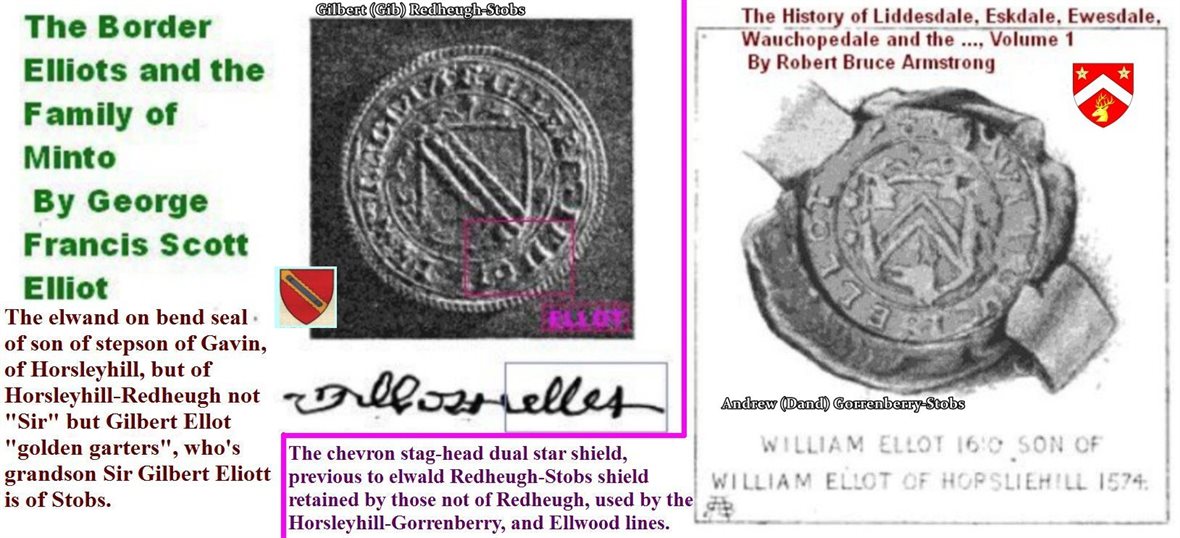
https://books.google.com/books?id=t8g3AQAAMAAJ&q=Gilbert#v=onepage&q=Gilbert&f=false https://books.google.com/books?id=nFr7oQEACAAJ&pg=PR1&source=gbs_selected_pages&cad=3#v=onepage&q&f=false We been separated because of Border Pacification (genocide), making of the Middle Shires, and the United Kingdom, for over four centuries. http://home.kpn.nl/pu6qs9/ellot_clan.htm THE ELLIOTS in SELKIRK Ellots recorded as BURGESSES, BAILLIES and COMMISIONERS of SELKIRK have been listed. DATES RANGING BETWEEN Andrew (alias Dandie, or Dandie of the Cow) 21/3/1565 – 2/5/1591 https://elwald.com/clan-elliot-29th-chief-margaret-eliott-of-redhuegh-stobs/
Like
Belinda Dettmann
September 1 @ 4:46pm
Mark, the Border Elliotts are from the line of R-L21>S193. As you are from R-U106>S16361 it is likely that your Elliott line comes through a female Elliott, whose partner was killed in battle. In other words you do not descend from the Elliott Border chiefs in direct male line.
Like
Mark Elliott
September 1 @ 6:08pm
First of all you are referencing R-L21>L193, where abover 37% of the Elliot of the Redheugh-Larriston region are from, but I am from Gorrenberry and definitely note not of the chieftain Redhuegh line which branched off at Robert Elwald 9. Robert Elwald 10 acquired the lands of Redheugh and Larriston which contain the R-L193 DNA, likely brought down by the Douglas from Angus, migration to the valley of Glendinning where the R-L193 Glendinning, and Little are from in accordance with James V. Elliott Clade A-1 study. Gorrenberry is not of Redheugh, that is why Gorrenberry did not adopt the Redheugh shield/arms of 1566. Redheugh is the chieftain line, not Gorrenberry. https://gorrenberry.com/wp-content/uploads/2015/05/A1-Clade-Report.pdf
Like Jesse Elliott likes this
Mark Elliott
September 2 @ 12:45pm
Forgot I had published this link; https://gorrenberry.com/elliot-glendinning-r-l193-sub-l513/ added to it; https://gorrenberry.com/wp-content/uploads/2019/09/St-Clair-DNA-SNP.m4v.mp4?_=1
Like
Jesse Elliott
September 13 @ 12:21pm
I agree Mark. Scott of Satchells mentions 12 great families. If they were all of the same DNA line I would think he would say ONE great family. I’m sure there was a lot of intermarrying amongst them but there had to be several Y-DNA lines. Lot of I haplogroup Elliotts also.
Unlike You like this
 Mark Elliott
Mark ElliottSeptember 13 @ 8:14am
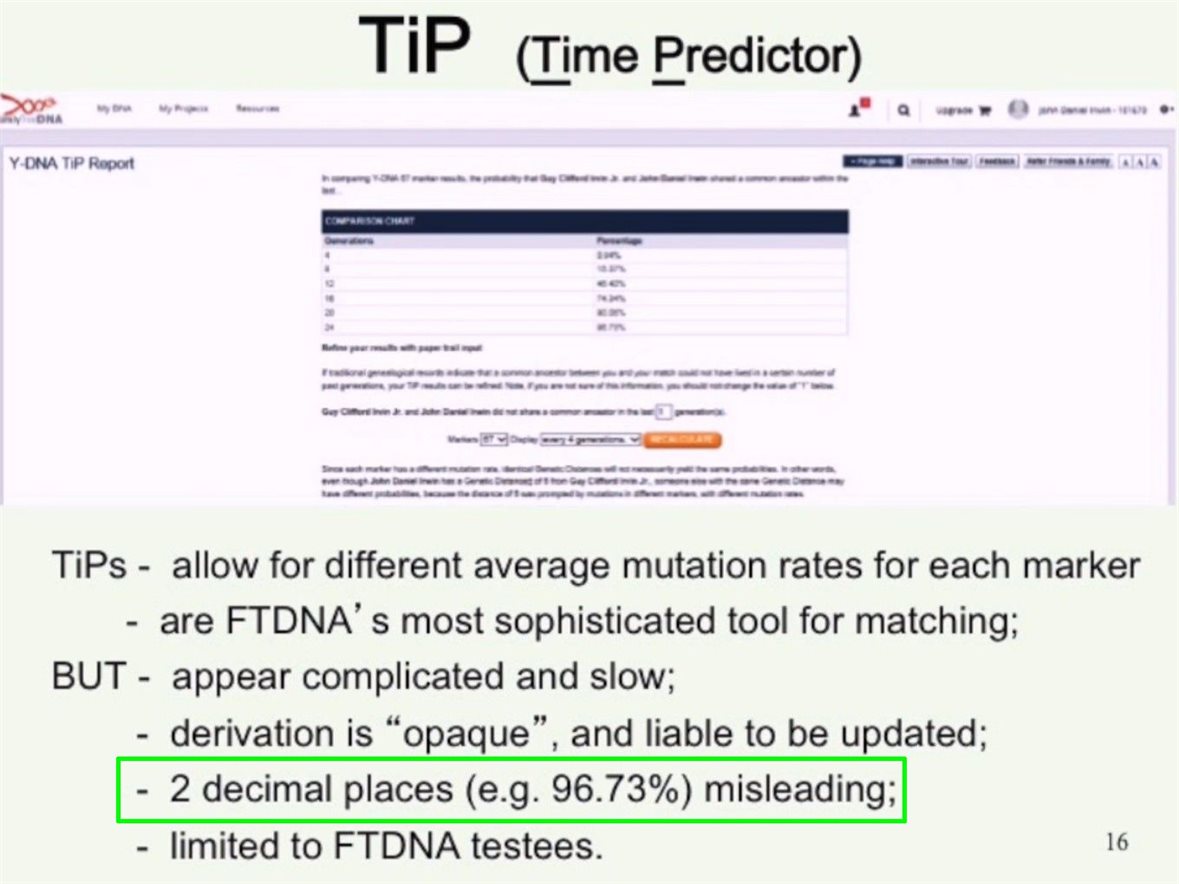
A great statement ‘2 decimal places (e.g. 96.73%) misleading:’ With FTDNA, not making the number of measured years per generation available shows their understanding of mathematics. The above shows that James M. Irvine, has a strong understanding of the mathematics when it is being applied to genealogical research. Numbers am familiar with are 30 and 25 years a generation. At 30±5 and at 25±2½, but will be utilizing a higher more mathematically precise at the units digit e.g. 27±½. For the mathematics to be correct the precision of the answer can not be more than the precision of the input. To get an answer such as 96.73% is mathematically correct, this shows the level of mathematical knowledge which FTDNA is utilizing.
Like
 Mark Elliott
Mark ElliottSeptember 1 @ 8:51pm
Like
1 Comment
Mark Elliott
September 2 @ 8:09am
THE GUIDE TEAM, and I know that genealogy is not rocket science. YOU CAN DO DNA. FTDNA showed me that their mathematics was incorrect, with their TIP calculator, by using measured 30 years a generation, a number which has only one significant digit, and coming up with percents to the nearest hundredth, which is mathematically impossible. In genealogy, if you give me information, on top is THE FAMILY KNOWS BEST. Next one needs a different perspective, and to make family one must listen to the sex opposite of you. That especially goes in genealogy. Genealogy, is based on multiple estimations. For my DNA, for the surnames, Gresham (Grisham, Grissom), Cave, and Scarborough (likely Scorborough, UK, but Scarborough, UK is close enough), am matching the first twelve markers. These are places along the North Sea which Scandinavians came into. The Normans and Scandinavians fought at Hastings carrying similar autosomal DNA, in accordance to the PoBI project. As with the Church of Latter Day Saints, two philosophies exist, one of kings with kings in authority, and one of borderers which just pitch in. Similar to the difference between their first and second president, of the Church of Later Day Saints. Brigham Young is the border reiver. For genealogy it is a pitch-in and a sharing, when authority intervenes, or ‘in-laws’ are kicked out it does not work. Now people you are sharing information among family these are the ones doing genealogy. With all surnames people are likely to be from different regions. With ‘Gresham’ (Grisham, Grissom), most likely from Gresham, Norfolk, East Anglia, England. With ‘Cave’, also having French origins, not so much. With ‘Scarborough’, it could be ‘Scorborough’ also which is closer to ‘Cave’, but both are in the same region. Over time there will be some NPE, among them. Y-DNA reaches way back in time, and the SNP are beginning to reach into the era of genealogical researchers like you and I. On the first marker a ’14’ is rare, and there are higher proportions of first marker 14’s for Gresham, Norfolk, and Scarborough. Gresham is a place name it ends with ‘ham’, and Scarborough, is a place name it ends with ‘borough’ originally ‘burgh’, as in Edinburgh, but pronounce the same. Cave is likely a place name after a family, of Cave, likely a Norman name, and could by also a place name in France, but those ending in ‘ham’, and ‘borough’, are of names originating in the today’s England. So for people who have a first marker ’14’, and match the first twelve markers with mine for the names Gresham, Cave, and Scarborough, when their surname adoption came about they were from that locality, like Cottingham. Webster’s ‘cot’, a small house or Brigham, a ‘bridge house’. It should be noted the name is sometimes written “John de Doe” where ‘de’ means of, and in time is dropped, the name then becomes “John Doe”. If searching names as in Google Books, one may search “de Doe”, if it exists in that manner, try to find it on a map, the recent ones first, then older ones. If the mapping locality corresponds with census concentration data software, then it likely originate in that locality. Brigham and Cottingham are localities of East Riding, Yorkshire and show ‘hot spots’ https://named.publicprofiler.org/ at their respective localities, so I can say if you have the surname Brigham or Cottingham, and are Y-DNA matching on the first twelve markers a number of people with that surname then you are certainly most likely from that locality. If your Cave relatives, match my first 12 Y-DNA markers then they received their surname from the region of N&S Cave, East Riding Yorkshire.
Like
Gail Andrews Hardy T124143
September 2 @ 1:45pm
My closest Cave is my 10th great grandmother, Mary Cave (1556-1593), daughter of my 11th great grandfather, Anthony Cave (1517-1558). Anthony lived and died in Buckinghamshire, England. Mary was born in Buckinghamshire and died in Essex. She married Jerome Weston.
Unlike You like this
Mark Elliott
September 2 @ 3:21pm
No Y-DNA trail then?
Like
Gail Andrews Hardy T124143
September 2 @ 5:57pm
No, just atDNA.
Like
 Mark Elliott
Mark ElliottSeptember 1 @ 11:44pm
0. Elwald de Schinckel https://gorrenberry.com/wp-content/uploads/2019/09/Elwald-of-Schinktlef.jpg . . 1. Alan Elfwald of Norfolk, E Anglia ca 1250. https://en.wikipedia.org/wiki/Beck_Hall 2. Robert Elwald of Norfolk/Rimington, West Riding Yorkshire, Northumbria (Lancashire) 1304. https://en.wikipedia.org/wiki/Rimington 3. Robert 2 4. Robert 3 5. Robert 4 6. Robert 5 7. Robert 6 8. Robert 7 9. Robert 8 10. Robert 9 11. William Elwald of Gorrenberry 12. Robert Elwald (Archeis Hob) of Gorrenberry (adopted by uncle Archibald) https://gorrenberry.com/wp-content/uploads/2018/06/Gorrenberry-Family-Tree112.png 13. Andrew (Dand the Cowie) Elwald of Horsleyhill 14. Robert Elwald of Stobs/Gorrenberry (Clementis Hobs) 15. Dan-Daniel Ellot/Elliot/Elliott of Scotland/Tullykelter Fermanagh https://en.wikipedia.org/wiki/Tullykelter_Castle 16. Robert Ellot Tullykelter 17. Daniel Ellot/Elliot of Ulster/Massachusetts 18. Daniel Elliot Salem Trials http://staging.salem.lib.virginia.edu/texts/tei/swp?term=William%20Proctor&div_id=n106.9&chapter_id=n106 19. Johnathan Sr 20. Johnathan Jr 21. John 22. Comfort Elliott 23. SA (Sherburn Amando) 24. AW (Amando Wilcox) 25. Mark 26. Loren Spencer 27. Mark Stephen Chiefs line is based on 1st, except chief 29, Margaret is an only child, therefore 29, to my 27, and figure she is my 17th cousin twice removed. https://elwald.com/clan-elliot-29th-chief-margaret-eliott-of-redhuegh-stobs/ https://gorrenberry.com/robert-elwald-clan-elliot-chief-1/
Like
 Mark Elliott
Mark ElliottSeptember 1 @ 8:53pm
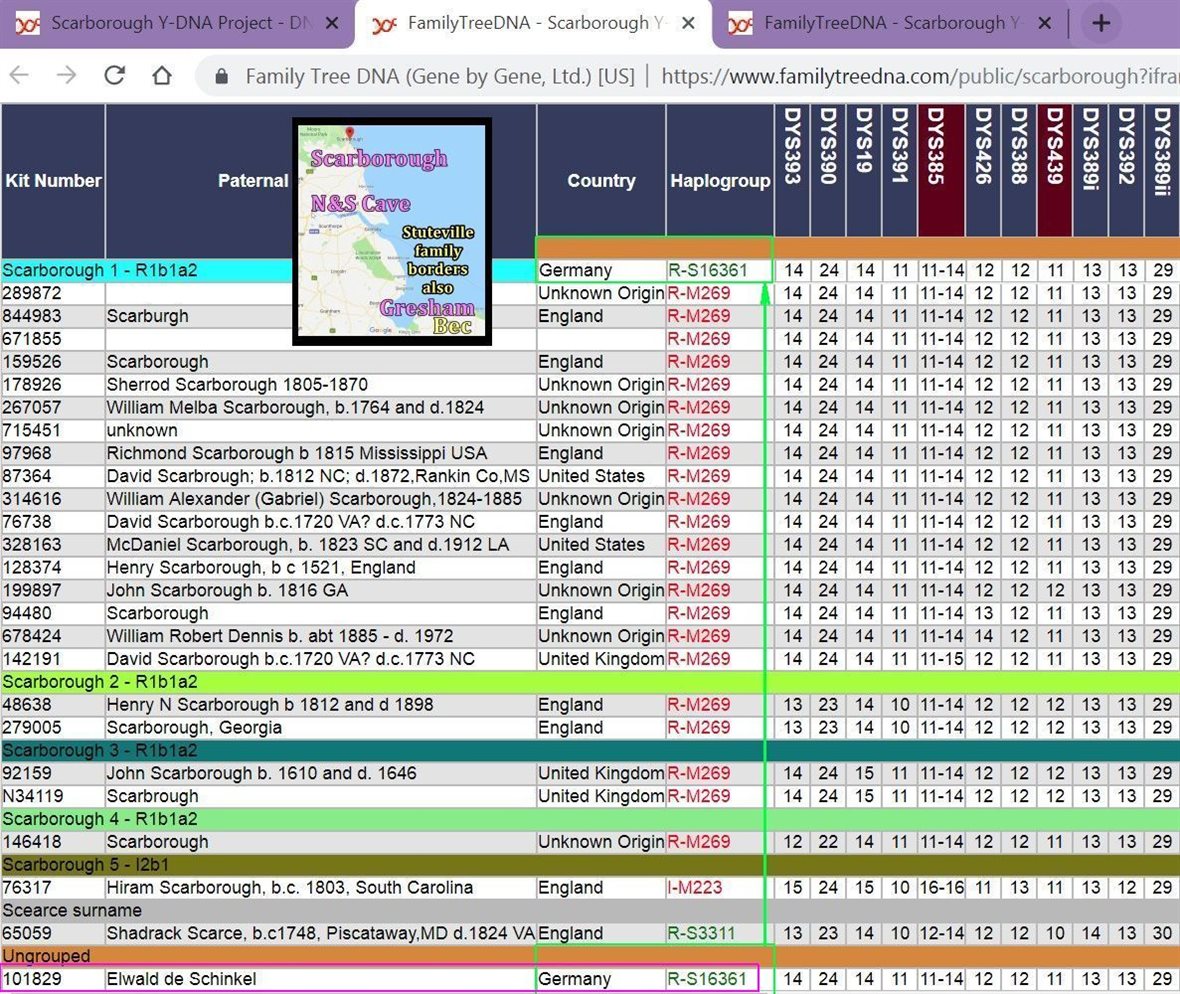
https://www.familytreedna.com/public/scarborough?iframe=yresults Am the lab rat, share my data-documentation with the genealogical genetic scientists to see what they can come up with. The ones who accuse people of the family from outside the family as liars, especially with the math-science, computer, engineering applied also in and instructional English as a Second Language to worldwide languages, and those indigenous to the Americans, plus at the center of archaelogical-anthropological America southwest. Can not allow not allow witch hunting authorities to hang the scientific genetic accuracy, that which is most accurate by hanging it making it into a lie. BY MEASUREMENT, NOT WORDS.
Like
 Mark Elliott
Mark ElliottSeptember 1 @ 8:50pm
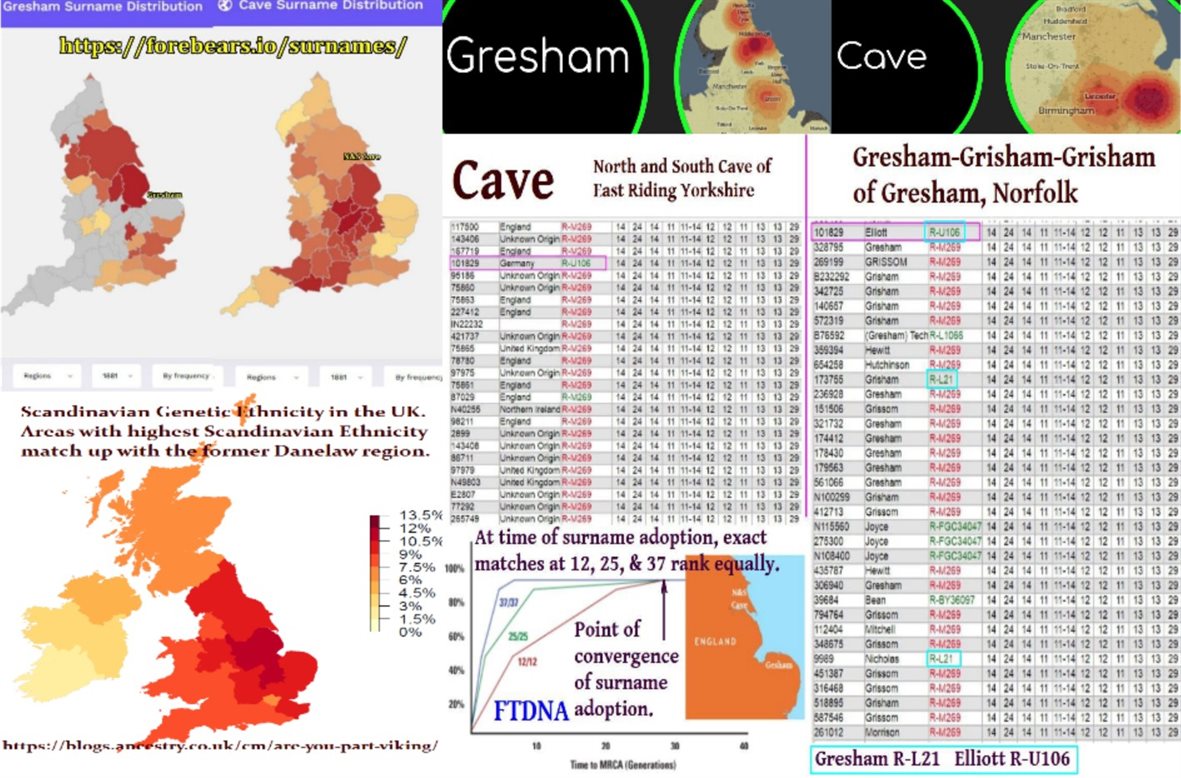
https://www.familytreedna.com/public/CaveFamilyHistorySocietyDNA?iframe=yresults https://www.familytreedna.com/public/Gresham_Grissom?iframe=yresults https://www.cambridge.org/core/services/aop-cambridge-core/content/view/54E19CAFF9AC2BEB39EAEC826BEDBC63/S0003598X16001939a.pdf/people_of_the_british_isles_project_and_viking_settlement_in_england.pdf
Like
 Mark Elliott
Mark ElliottSeptember 1 @ 8:22pm
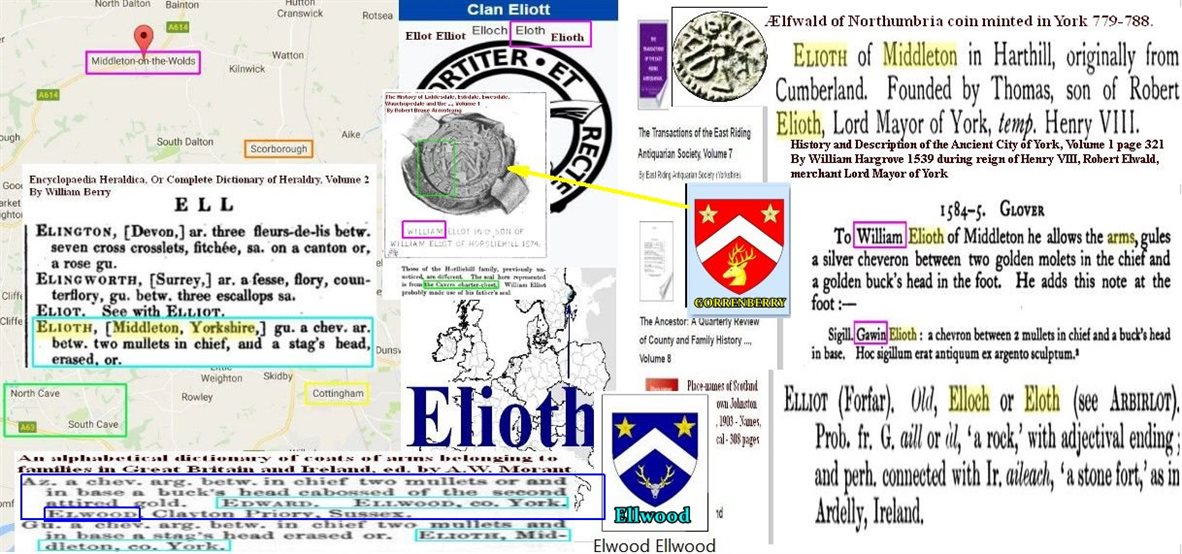
Like
 Mark Elliott
Mark ElliottSeptember 1 @ 6:21pm
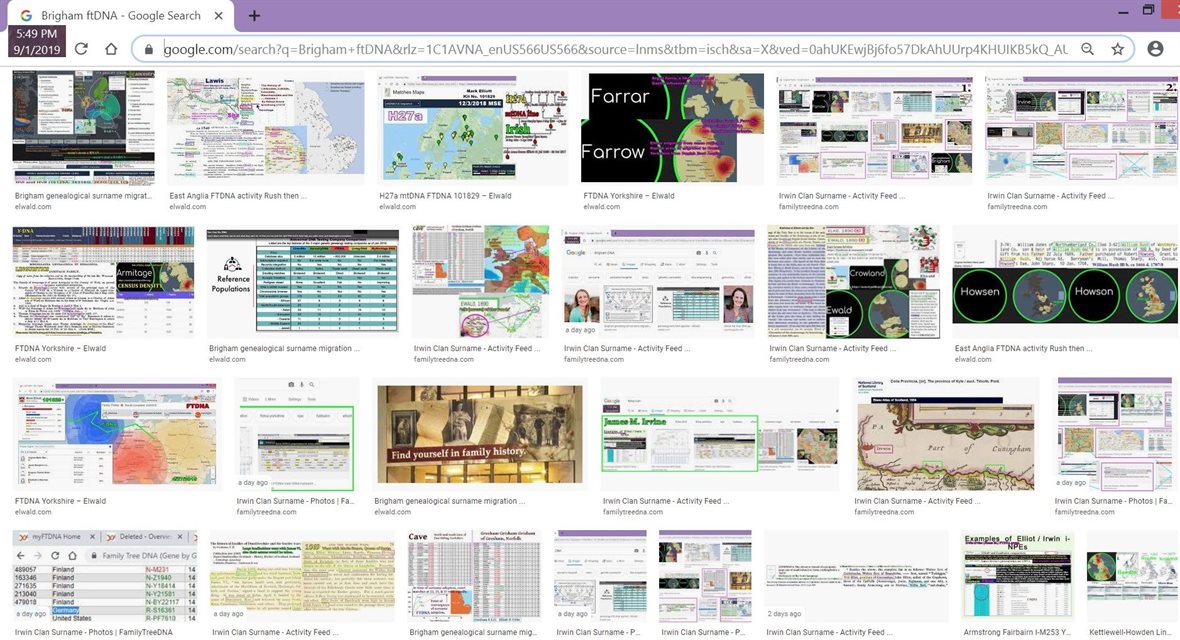
Brigham Young and I Mark Elliott are irritated to extremely poor standards in genealogy. All of the above graphics were uploaded by me and are being shared by Brigham genealogists. Instead of in Google Images ‘Brigham DNA’, this time it is ‘Brigham FTDNA’.
Like
 Mark Elliott
Mark ElliottSeptember 1 @ 6:14pm
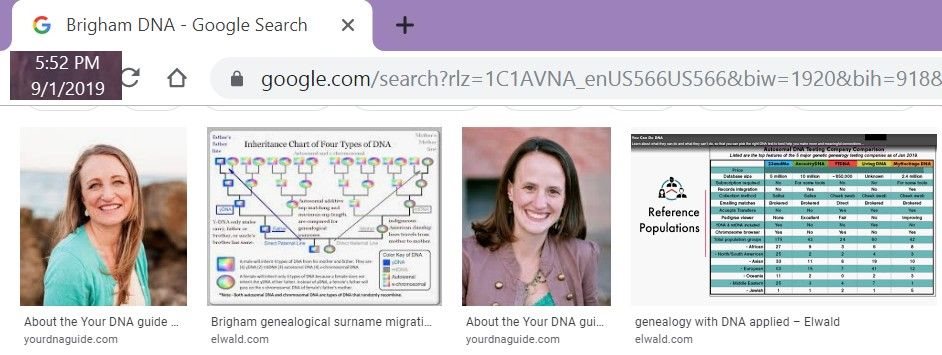
Belinda Dettmann 1 hour ago Mark, the Border Elliotts are from the line of R-L21>S193. As you are from R-U106>S16361 it is likely that your Elliott line comes through a female Elliott, whose partner was killed in battle. In other words you do not descend from the Elliott Border chiefs in direct male line. You are not a genealogist, because you will not go to Google Images and put in “Brigham DNA”. You will not read the links which go with the first four images, and you will refer to a second generation genealogist-engineer, who has been doing genealogy for more than a half century as a lair about ones own Y-DNA line, when the first rule of genealogy in order to even be considered a genealogist the family is correct. Dad’s research was FTDNA correct to 28 Mar 1692, record of Daniel Elliott of the Salem Witch trials. Yet if I am today to present results most accurately, someone will say of not my family who has not worked in the applied world as a math science, computer, engineering fields as and engineer, instructor at secondary and university level, and as with the authorities of the witch trials did with Daniel’s testimony make a lie out of the truth. By doing this at the time of Daniel Elliot, nineteen innocent people were hung and one was crushed. Genetic-genealogists, from/of Brigham Young University are scrutinizing the data-documentation I have shared and will come to there own results, like highly qualified people in the genetic genealogical sciences do.
Like
 Mark Elliott
Mark ElliottAugust 31 @ 9:29am
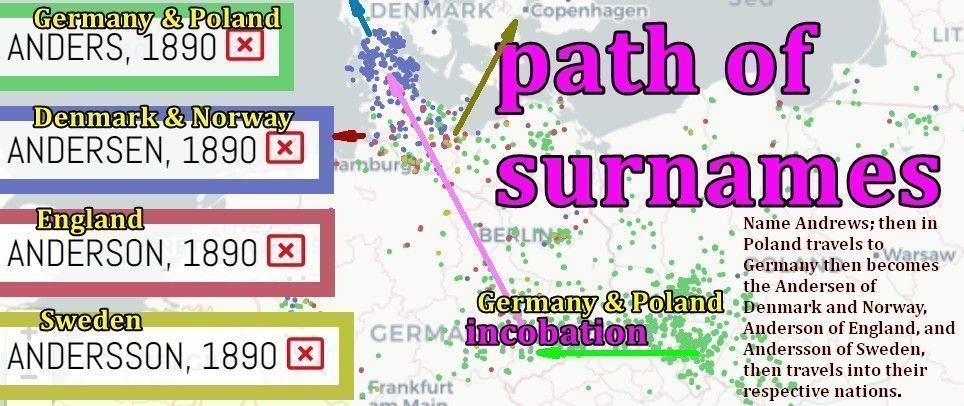
Like
Belinda Dettmann
August 31 @ 6:21pm
St Andrew was the patron saint of Scotland long before 1890. The names Anders and Andrew can be found all over northwest Europe from earliest times.
Unlike You like this
Mark Elliott
August 31 @ 6:37pm
Above gives a map locality for Anders to have a census concentration at the southern part of the border in both Germany and Poland. Anders is the base prefix for names Andersen, Anderson, and Andersson. Andersen showing strength in Denmark. It is felt with surname adoption it is kind of like putting a drop of food die in water, the concentration is likely near where it began, though it spreads all over northwest Europe, like the above shows for Anders.
Like
Belinda Dettmann
September 1 @ 4:00pm
Please keep comments to Northumberland subjects, not all over NW Europe.
Like Nigel Douglas likes this
 Mark Elliott
Mark ElliottSeptember 1 @ 3:29pm
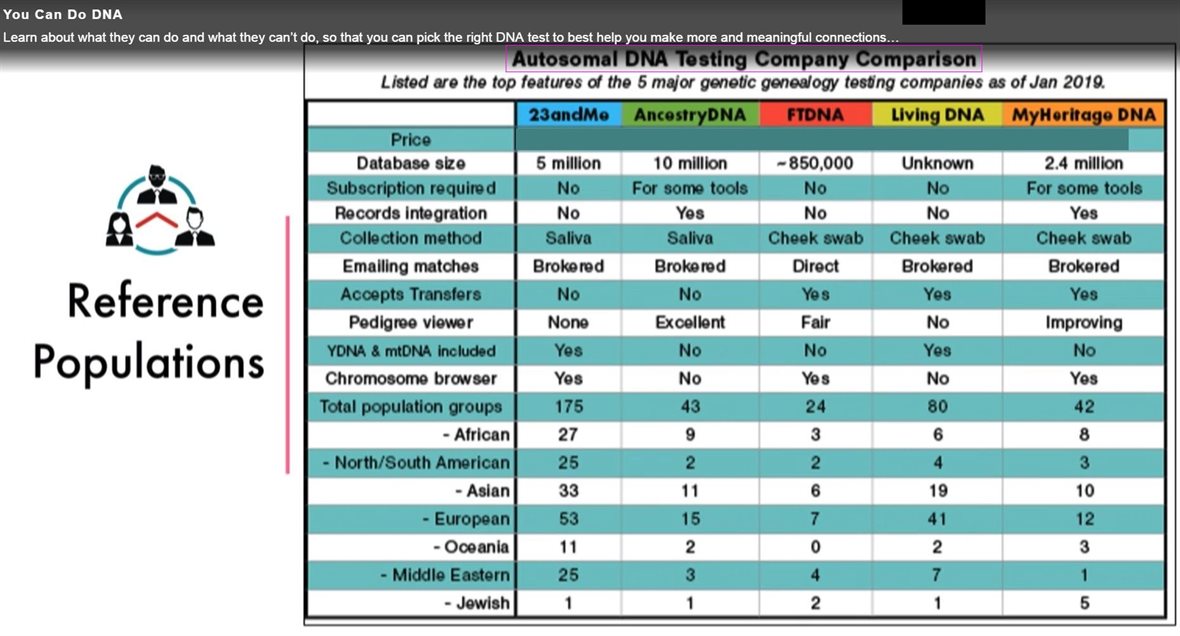
Autosomal testing company comparisons. https://www.yourdnaguide.com/about YOU CAN DO DNA
Like
 Mark Elliott
Mark ElliottSeptember 1 @ 3:28pm
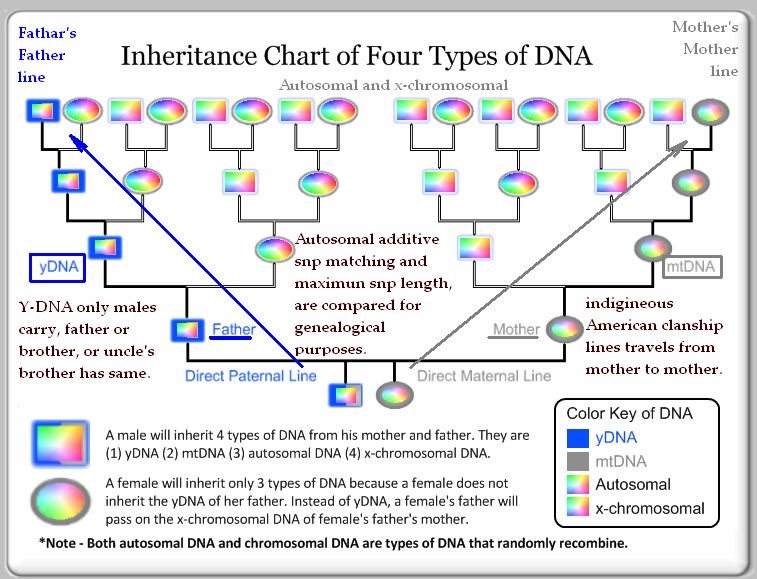
Like
 Mark Elliott
Mark ElliottSeptember 1 @ 1:50pm
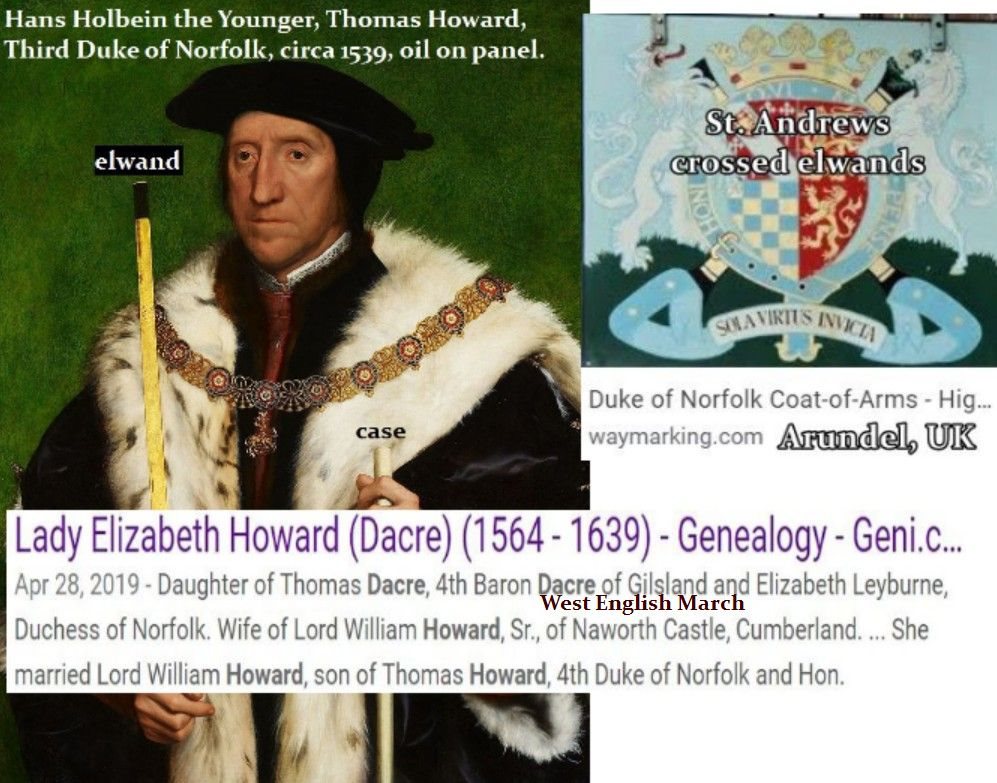
The Redheugh shield/arms adopted about 1566 the ‘elwand’. An elwand is a standard sixteenth century measurement of lenght, which name is biblical, but many christian nations would have an elwand of various length, England 45 imperial inches, and Scotland a hair more not being on the English standard than 37 inches. The belt of Orion is noted to be the “king’s ell/eln/el”. Guess the king of England was fatter than the king of Scotland. The Elwald split, Gorrenberry to Ulster at time of Border Pacification (genocide), for a genocidal flag “The Union Jack”, which has separated our family like borders have separated them for over four centuries. Then ‘transported as slaves to the colonies’ Hamiltonian POW Royalist Charles II, Scots fighting the forces of Cromwell at Worcester, in the Cromwellian Civil. Those Tories trying to make a border in Ireland, my patriotic rebellious ancestors would around 1776 just string them up. The “elwand” symbolizes the Elwald of Redheugh and Gorrenberry, and says, ‘by measurement, not by words’.
Like
Mark Elliott
September 1 @ 3:06pm
Fitting to my line which supported Queen Marie Stuart of Scotland at Langholm 1569 with a bunch of other reivers of the West and Middle Scottish Marches, and were in on the rescue of Kinmont Willie Armstrong, with the Bells, from Carlisle Castle with Auld Walt of Harden in 1596. That Scrope took him on a truth day and Kinmont Willie needed to be rescue, so he could live out his days in his tower on the River Sark, near the Scots Dike, and be buried in Morton Kirk (church) cemetery there.
Like
 Mark Elliott
Mark ElliottSeptember 1 @ 2:47pm
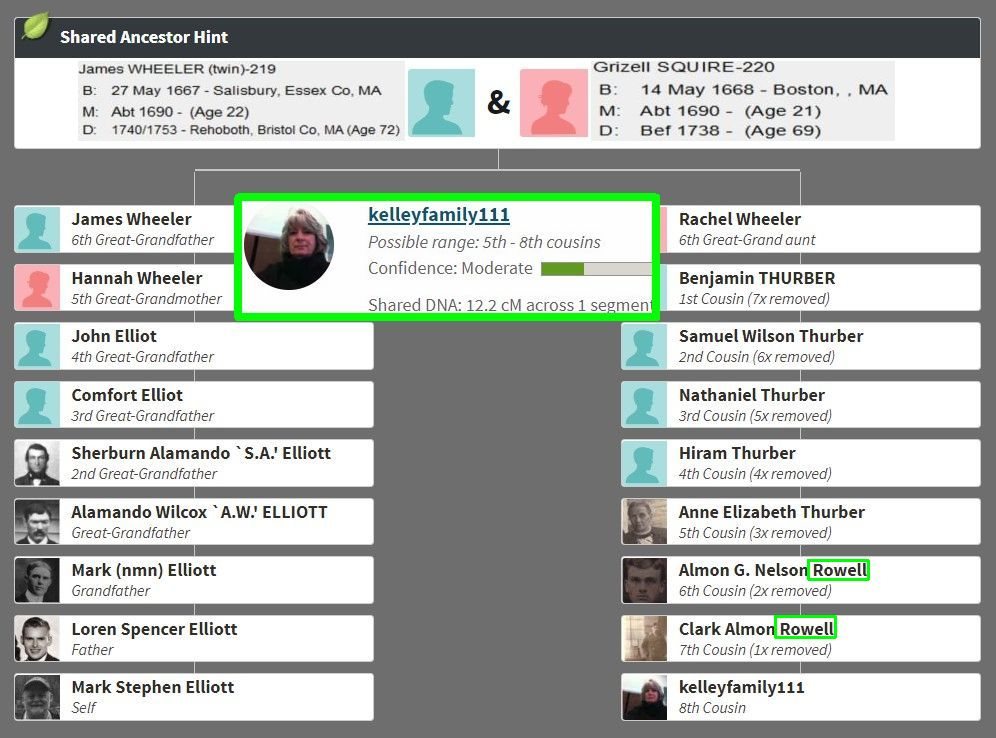
Pedigree viewer from Ancestry. Gail Andrews Hardy T124143 38 minutes ago “Hi Mark, I ran our kits and came up with two small matches on Chromosomes 7 and 12 at 250 SNPs and 3 cMs. When I dropped it down to 200 SNPs and 2 cMs there were matches all over the place, multiples on several. The only Chromosomes that didn’t have matches were 5, 14, 15, 19, 20, 21, and 22. These matches are so small that if they are really matches and not just genetic noise, they would be very very far back.” Still in a state of learning. How does that Gail compare to the above? Both Gedmatch and Ancestry, use autosomal DNA.
Like
 Mark Elliott
Mark ElliottAugust 31 @ 8:33am

http://www.therjhuntercollection.com/resources/muster-rolls-c-1630/search-muster-rolls/ Ulster First Surname Barony/Lands Landlord/Estate County Gilbert Hardy Dungannon Captain A. Sanderson Tyrone
Like
Gail Andrews Hardy T124143
September 1 @ 9:17am
My ex-husband’s family came from Derbyshire, England.
Unlike You like this
Mark Elliott
September 1 @ 10:25am
Comparing Kit A269034 (*lawismarkellot) [Migration – F2 – A] and T124143 (Gail Hardy) [Migration – F2 – T] now shared match found. at https://www.gedmatch.com
Like
Gail Andrews Hardy T124143
September 1 @ 2:07pm
Hi Mark, I ran our kits and came up with two small matches on Chromosomes 7 and 12 at 250 SNPs and 3 cMs. When I dropped it down to 200 SNPs and 2 cMs there were matches all over the place, multiples on several. The only Chromosomes that didn’t have matches were 5, 14, 15, 19, 20, 21, and 22. These matches are so small that if they are really matches and not just genetic noise, they would be very very far back.
Unlike You like this
 Mark Elliott
Mark ElliottSeptember 1 @ 11:10am

Like
 Mark Elliott
Mark ElliottSeptember 1 @ 11:07am
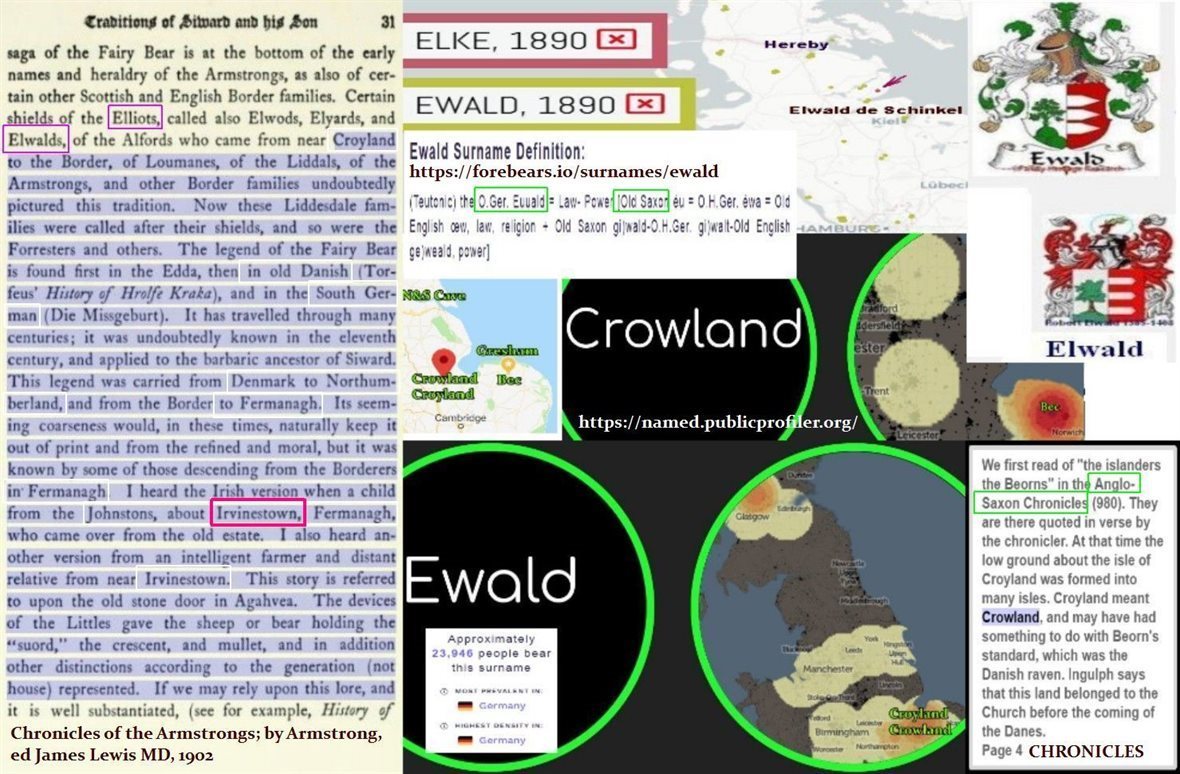
https://archive.org/details/chroniclesofarms00arms/page/n13 On the Elwald/Ewald shields above there are horizontal red and white stripes.
Like
 Mark Elliott
Mark ElliottSeptember 1 @ 10:46am
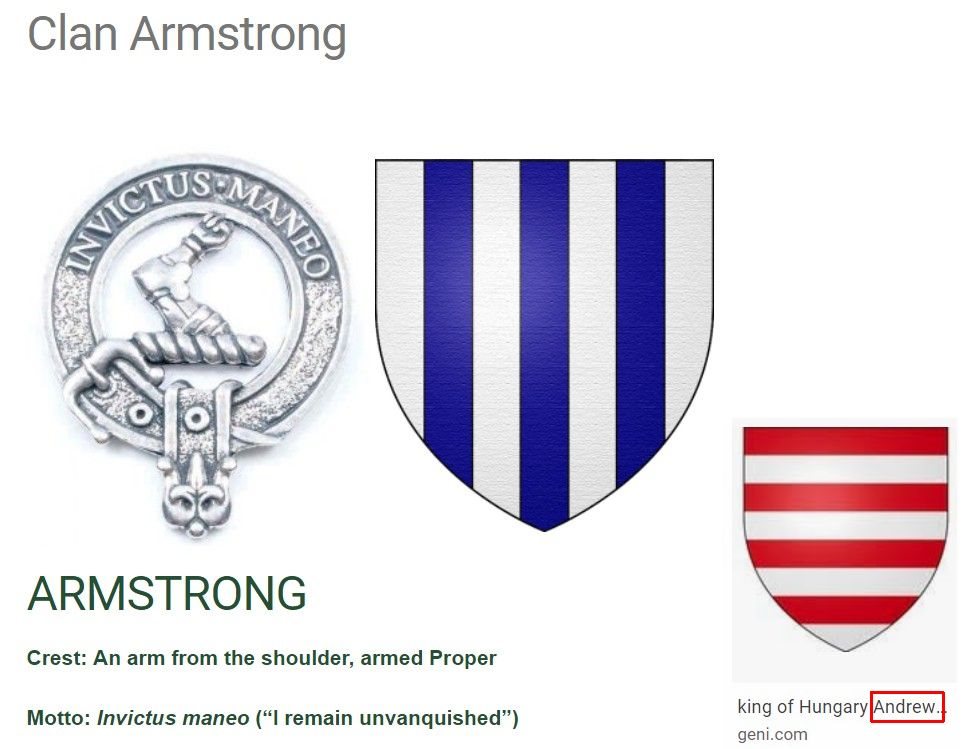
Number one in genealogy ‘THE FAMILY KNOWS BEST’, number two for the men in genealogy ‘LISTEN TO THE LADIES’; Gail Andrews Hardy T124143 1 hour ago “My Andrews supposedly goes back to Andrew I Arpad, King of Hungary.” Name, Mark Stephen Elliott, Stephen after Stephen Peter Barna. Barna are found highly concentrated in Hungry. https://en.wikipedia.org/wiki/Andrew_I_of_Hungary Predecessor; https://en.wikipedia.org/wiki/Peter,_King_of_Hungary Amstrong are number one allies to Elwald-Elliott. Striped vertically or horizontal shields are uncommon. Lines of Redheugh-Stobs Ellot Gilbert (Gib) line, split with Gorrenberry-Stobs Ellot Andrew (Dan) at time of Scottish-English Border Pacification (genocide). Maybe that is why I can not seem to keep those Armstrong away. My Saxon Elwald line has been ‘vanquished’, but not by the Armstrong. Trying to make it become ‘unvanquished’, like the Armstrong. https://archive.org/details/chroniclesofarms00arms/page/n13
Like
 Mark Elliott
Mark ElliottAugust 31 @ 9:29am

Like
Gail Andrews Hardy T124143
September 1 @ 9:19am
My Andrews supposedly goes back to Andrew I Arpad, King of Hungary.
Unlike You like this
 Mark Elliott
Mark ElliottAugust 31 @ 1:00pm

https://www.libraryireland.com/gregg/gregg-volume.pdf https://www.peopleofthebritishisles.org/ The Proto-Germanic R-U106 DNA traveled with the German Language, carrying the words of the ‘Fair Bear’; of the ‘Wolf’, ‘Elk’ (moose in America), and ‘Bear’ (pronounced the same in Germany, but spelled; Bär) with them. Map above shows that people of Northuberland may not have migrated northward of the border language, but onto Ulster.
Like
 Gary Bradley has a question!
Gary Bradley has a question!August 30 @ 12:09pm
“Any Broadley or Bradley descendants here? ”
Like
Gail Andrews Hardy T124143
August 31 @ 7:28am
I have some Bradleys but only one line from England, Wiltshire and Essex. The rest are from Pennsylvania.
Like
 Mark Elliott
Mark ElliottAugust 30 @ 8:57pm

Gary Bradley 2 hours ago Yes, you are well informed. My Bradley/Broadley family is from Yorkshire, but I am looking for a Northumberland and Scottish connection. Given https://www.familytreedna.com/groups/bradley/about/background most claim England and Ireland. 1630 muster and present day distribution shows Ireland, though some Bradley migrated to Scotland, if you are beyond the UK in a former English Colony then your family stepping off point to that colony likely from Ulster, North(ern) Ireland.
Like
 Mark Elliott
Mark ElliottAugust 30 @ 1:40pm
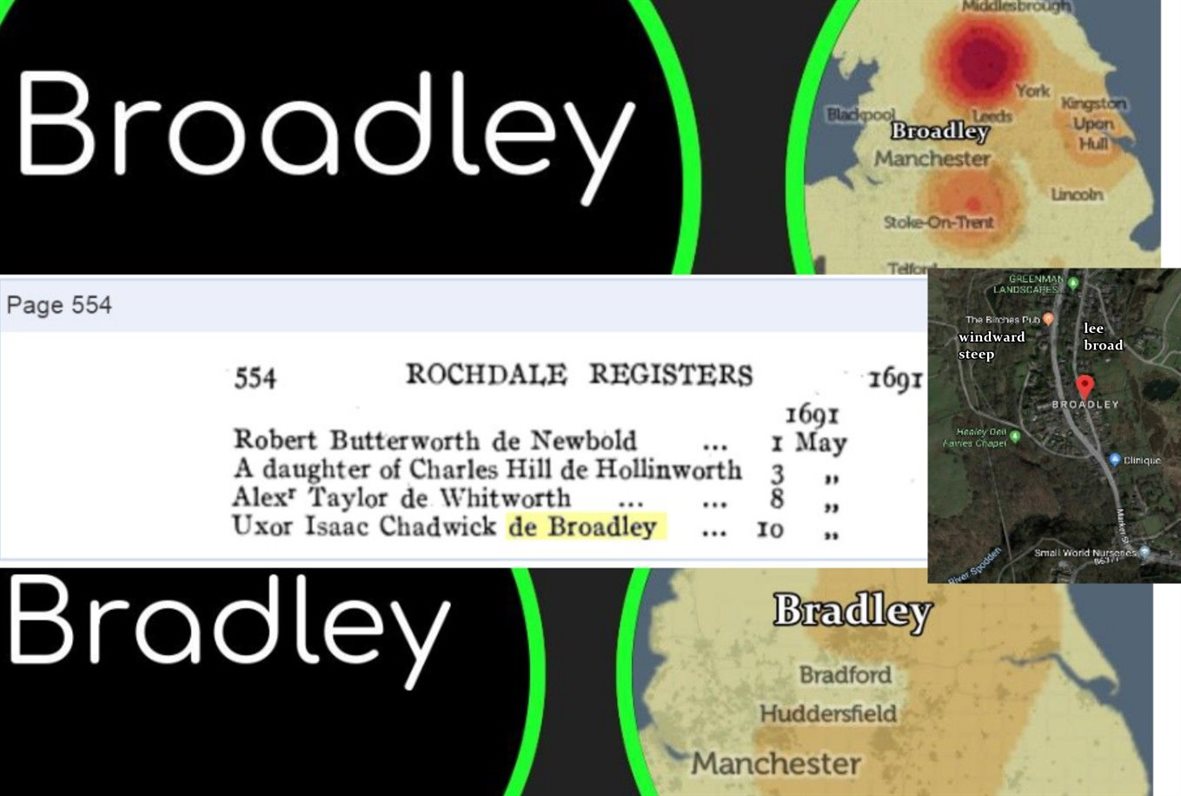
Gary Bradley, A lot of times the name Broadley, will evolve into Bradley, which is likely in your case, but there is a name locality near Broadley called Bradley, but others in England such as a North Bradley down south, so this leads me to believe since you brought it foreword the name originate from Broadley. Broadley, Whitworth, UK, fits the description and locality. If you are matching by Y-DNA people with the name Broadley, then most likely your name was Broadley of this locality, because it is most likely that the name would take away a letter ‘o’ than add it. Broadley is from the Anglo-Broadlee, which means a valley broad on the lee-leeward east side and steep on the windward west side this is the locality Broadley is located in.
Like Gary Bradley likes this
Gary Bradley
August 30 @ 6:52pm
Yes, you are well informed. My Bradley/Broadley family is from Yorkshire, but I am looking for a Northumberland and Scottish connection.
Like
 Mark Elliott
Mark ElliottAugust 30 @ 9:22am
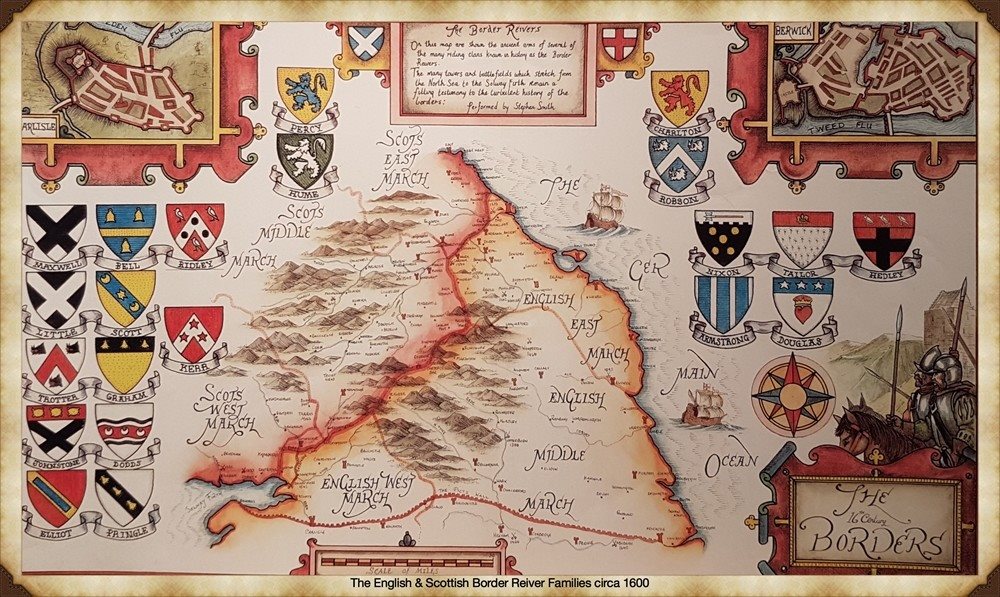
50 years ago when a Nixon was president, an Armstrong stood on the moon. Armstrong, Elliot, and Nixon along with Crozier http://clancrozier.com/ are of the Scots Middle March.
Like Jesse Elliott and Gail Andrews Hardy T124143 like this

John Wilkinson
August 30 @ 12:57pm
I like that graphic. Is it publicly available in decent resolution?
Like
Mark Elliott
August 30 @ 1:51pm
Borders; https://www.painters-online.co.uk/gallery/art-view,picture_200754.htm Northumberland; https://www.painters-online.co.uk/gallery/art-view,picture_200753.htm About the best resolution I am able to find. From a site on the artist.
Like John Wilkinson likes this
 Mark Elliott
Mark ElliottAugust 28 @ 12:35pm

John Wilkinson helped me with this one; Rescue of Kinmont Willie Armstrong from Carlisle Castle 1596, which included Buccleuch (Scot adopted later the name Scott), Bell, Ellot (Elliot adopted c.1650), and Armstrong. Ulster muster 1630; First Surname Barony Landlord/Estate County William Bell Fewes J. Hammelton Armagh George Bell Fewes J. Hammelton Armagh George Bell Fewes J. Hammelton Armagh Andrew Bell Fewes J. Hammelton Armagh George Bell Fewes J. Hammelton Armagh Robert Ellot Fewes J. Hammelton Armagh John Ellot Fewes J. Hammelton Armagh Archball Young Fewes Sir A. Atchison Armagh Adam Young Fewes Sir A. Atchison Armagh Alexander Scot Fewes Sir A. Atchison Armagh John Scot Fewes Sir A. Atchison Armagh James Scot Fewes Sir A. Atchison Armagh Ralph Scot Fewes Sir A. Atchison Armagh Walter Scot Fewes J. Hammelton Armagh http://www.therjhuntercollection.com/resources/muster-rolls-c-1630/search-muster-rolls/ https://gorrenberry.com/wp-content/uploads/2018/12/HISTORY-HUNTERS-Kinmont-Willie-Armstrong.mp4 https://gorrenberry.com/wp-content/uploads/2019/08/ballads-of-the-Border-Reivers..mp4 http://gorrenberry.com/wp-content/uploads/2015/07/HISTORY_IRELAND_Winter1994_pgs.25-29.pdf https://gorrenberry.com/wp-content/uploads/2019/02/Die-Riding-Clans-in-Ulster-von-Robert-Bell.pdf Ignore the name ‘Bighames’ above because it is too much like ‘Brigham’.
Like John Wilkinson likes this
 Mark Elliott
Mark ElliottAugust 28 @ 12:46pm
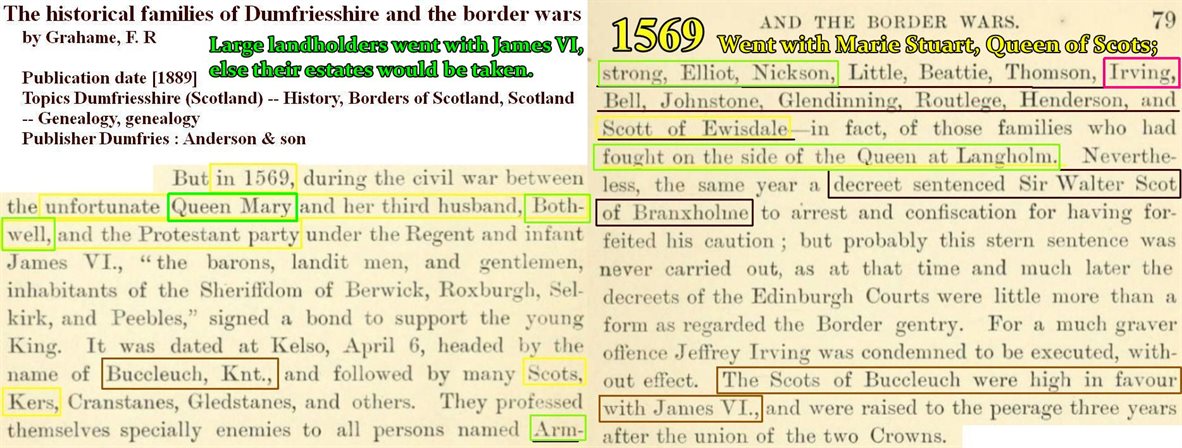
Like David Benson and John Wilkinson like this

 DAVID CLARK
DAVID CLARKAugust 27 @ 12:01pm
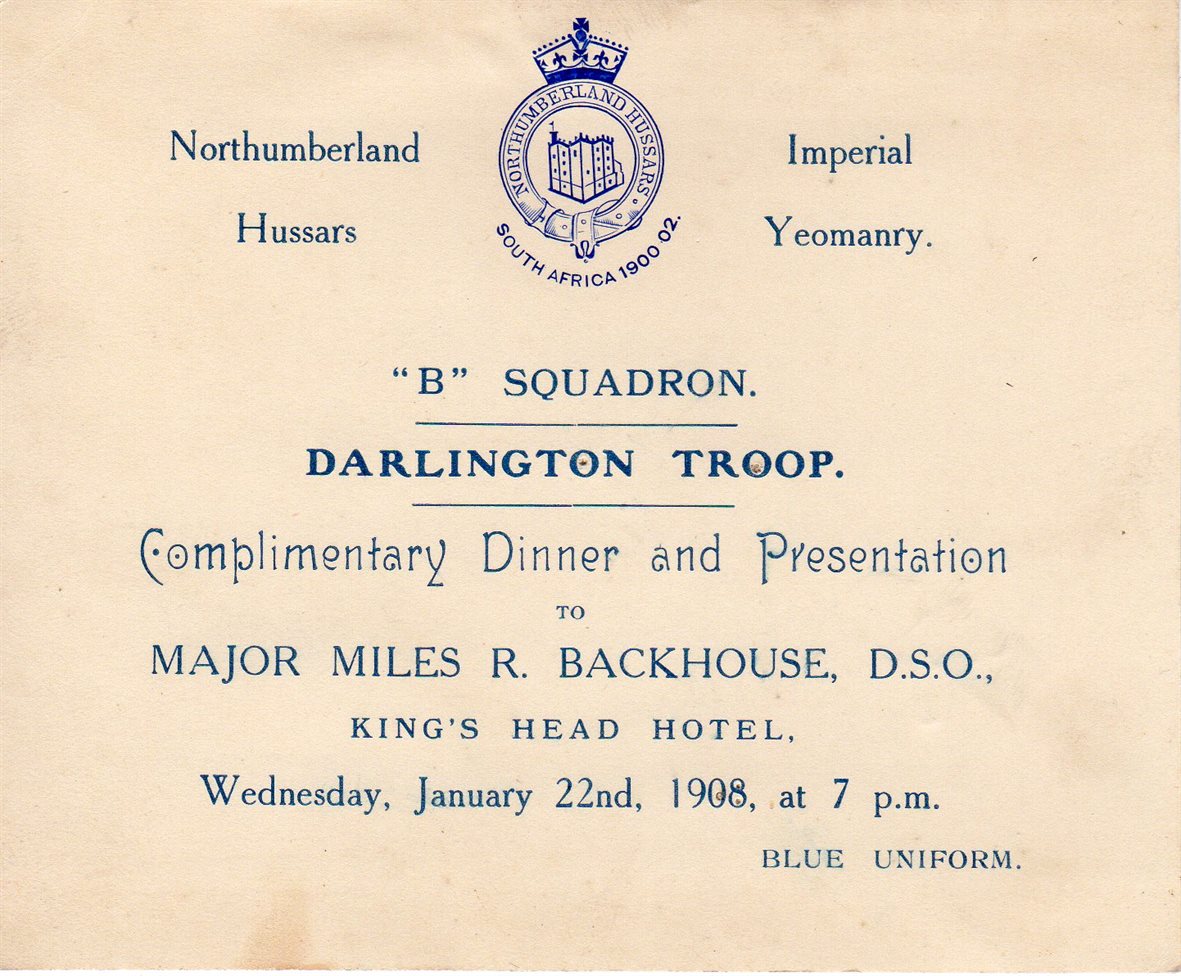
Like John Wilkinson likes this
DAVID CLARK
August 27 @ 12:02pm
from John Cyril’s keepsakes given to me by my mother, mtDNA
Like
 DAVID CLARK
DAVID CLARKAugust 27 @ 11:59am

Like
DAVID CLARK
August 27 @ 12:01pm
my grandfather, John Cyril Bailey, more on familysearch.org
Like John Wilkinson likes this
 Mark Elliott
Mark ElliottAugust 23 @ 7:56pm
A list of Border Reiver surnames from both sides of the border include: https://englandsnortheast.co.uk/ne/wp-content/uploads/2018/05/reivermapfull.jpg Anderson, Armstrong, Beattie, Bell, Blackadder, Bromfield, Burns, Carlisle, Carnaby, Carr, Carruthers, Charlton, Collingwood, Cranston, Craw, Croser, Crozier, Curwen, Dacre, Davison, Dixon, Dodd, Douglas, Dunn, Elliot, Fenwick, Forster, Gilchrist, Glendenning, Graham, Gray, Hall, Harden, Hedley, Henderson, Heron, Hetherington, Hodgson, Hume, Hunter, Irvine, Jamieson, Jardine, Johnstone, Kerr, Laidlaw, Latimer, Little, Lowther, Maxwell, Medford, Middlemass, Milburn, Mitford, Moffat, Musgrave, Nixon, Noble, Ogle, Oliver, Potts, Pringle, Radcliffe, Reed, Ridley, Robson, Routledge, Rowell, Rutherford, Salkeld, Scott, Selby, Shaftoe, Simpson, Stamper, Stapleton, Stokoe, Storey, Tailor, Tait, Thompson, Thomson, Trotter, Turnbull, Turner, Wake, Wilkinson, Wilson, Witherington, Yarrow, Young. https://englandsnortheast.co.uk/border-reivers/
Like John Wilkinson likes this
 Mark Elliott
Mark ElliottAugust 23 @ 5:37pm

It is bad enough to be a descendant of a notorious Liddesdale Border reiver Clementis Hobs, what is worst is being referred to as an elk (moose) of the woods. At least these days the elk (moose) seem to be invading Berlin.
Like
 Mark Elliott
Mark ElliottAugust 23 @ 2:38pm
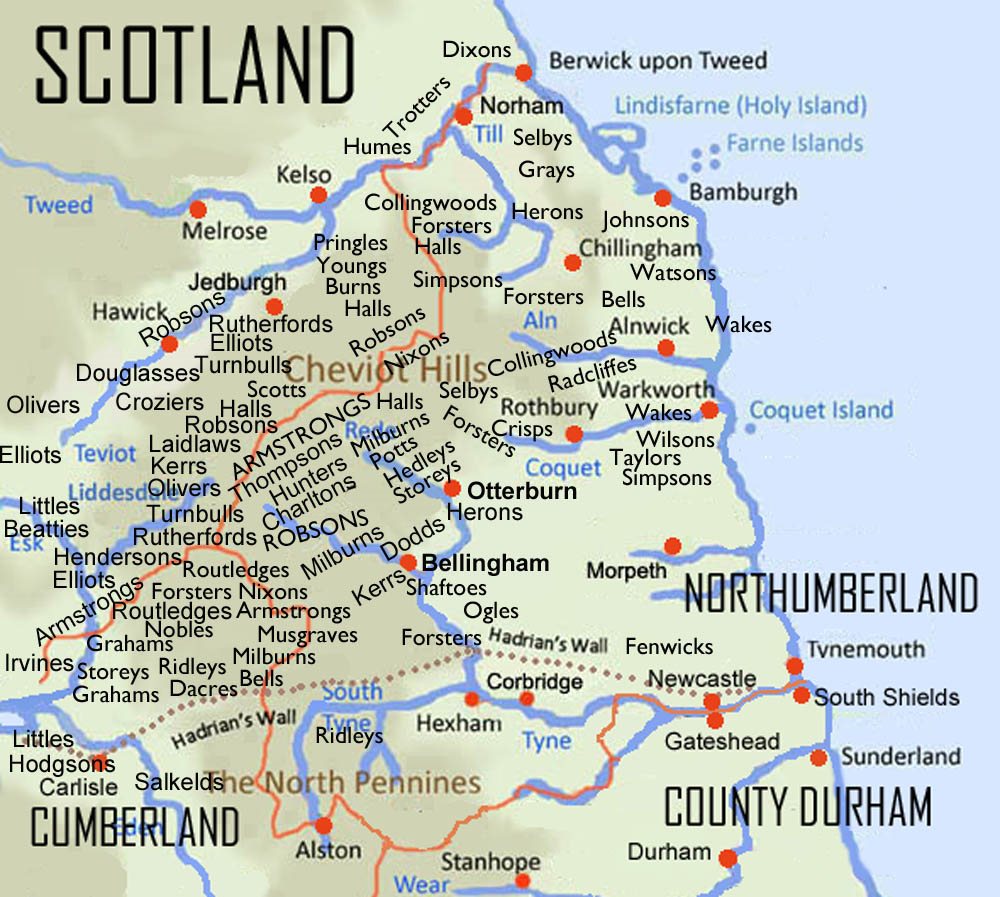
When ‘Declaration of Abroath c.1320’ the border was place, it was place between existing families. These families had loyalties to each other more so than their respective kingdoms. The borderlands were a self governing body onto themselves, and the border dukes Buccleuch, Cessford (Roxburghe), and Northumberland, sustained the land. Today they still try to protect the land, instead of subdividing it. It is felt that Ralph Percy, 12th Duke of Northumberland is doing the best job of it so far, but he is one of singularity on the English side of the border, where Buccleuch and Roxburghe are on the Scottish side of the border. All these families are interconnected through marriages. Previous to a border pacification and a United Kingdom, these families were the main managers of the borderlands. Though the Duke of Northumberland is doing a good job on his side of the border in preservation of the lands for borderers, the Dukes of Buccleuch, and Roxburghe, have to deal with the Scottish Ministry, which would like to own a wind farm corporations, and destroy any concept of a National Scottish Peace Park in conjunction with the Northumberland National Park on the English side of the border. As more and more people around the world search their genealogy, and find they are of border families, and at border pacification, the making of the Middle Shires was intended for preservation of both sides of the border, these families tracing their lines will not wonder whether the Duke of Northumberland is preserving the English side of the border but will be concerned about the desecration, of their ancestral lands by the Scottish Ministry, not allowing the Dukes of Buccleuch and Roxburghe to protect their lands for ancestors returning to visit from abroad to their family homelands.
Like DAVID CLARK likes this
 Mark Elliott
Mark ElliottAugust 20 @ 1:09pm

https://books.google.com/books?id=yYWqJF6UyAUC&printsec=frontcover&dq=Steel+Bonnets+Wilkinson&hl=en&sa=X&ved=2ahUKEwiHv5mnoZLkAhVYrp4KHeC3BpYQ6AEwAHoECAIQAg#v=onepage&q=Wilkinson&f=false “If anyone has a line on Wilkinson border reiver affiliation with any of the larger border clans, please let me know and post source.” John Wilkinson, From the English Side of the border. The Hunter and Thom(p)son rode with the Nixon, which where of the Scottish Middle March; Armstrong, Elliott, Nixon, and Crozier. Just a bunch of Middle March borderers no matter which side of the border you lived on. More like families than clans.
Like John Wilkinson likes this
John Wilkinson
August 21 @ 9:43am
Yes, have seen that too. Would love to make linkage back to these colorful hooligans, but so far it seems like the closest I get it a Wilkinson with no known genealogical connection who traces to Yester, Scotland in early 1700s. I presume he is from a parallel branch off a predecessor ancestor of both his line and mine descended from Thomas Wilkinson in Antrim (~1700, though he may have been born in Scotland). I have a number of low level Elliot/t matches too, interestingly.
Like
John Wilkinson
August 21 @ 9:45am
“England and Scotland, 1286-1603” by Andy King and Claire Etty. Page 158. Referencing Wilkinson/Rede/Hedley in 1498. Affiliation with Reed makes senses as the next vale over from Coquetdale (where I know there was a family of Wilkinsons at least by late 1300s) is Redesdale if my memory serves me correctly.
Like
Mark Elliott
August 23 @ 11:18am
John Wilkinson; “Yes, have seen that too. Would love to make linkage back to these colorful hooligans, …” “Affiliation with ‘Reed’ makes senses ..” Are you so sure about above because; The Death of Parcy Reed https://www.youtube.com/watch?v=PeToAGZF7gI “Thieves of Liddesdale Thair is ane callit Clementis Hob Fra ilk puire wyfe reiffis thair wob And all the laif Quhat ever thay haif The devill ressaif thairfoir his gob.” https://www.elwald.com/wp-content/uploads/2013/05/Clementis-Hob1.pdf “Clementis Hobs”, (ie Clement Crozier’s sister’s son Robert Elliott)..
Like
 Mark Elliott
Mark ElliottAugust 20 @ 1:58pm

https://books.google.com/books?id=p-xwDwAAQBAJ&pg=PT92&dq=Tynedale+Hunters+1540&hl=en&sa=X&ved=2ahUKEwiM0vHWm5LkAhVYsp4KHUd8CHAQ6AEwAHoECAYQAg#v=snippet&q=Wilkinson&f=false “If anyone has a line on Wilkinson border reiver affiliation with any of the larger border clans, please let me know and post source.” John Wilkinson, We the Armstrong, Elliott, and Crozier, are just a bunch of trouble makers.
Like John Wilkinson likes this
John Wilkinson
August 21 @ 9:38am
Yes, I have the book! There’s a Wilkinson or two in there who reived as well.
Like
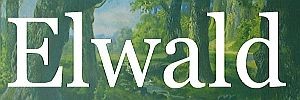
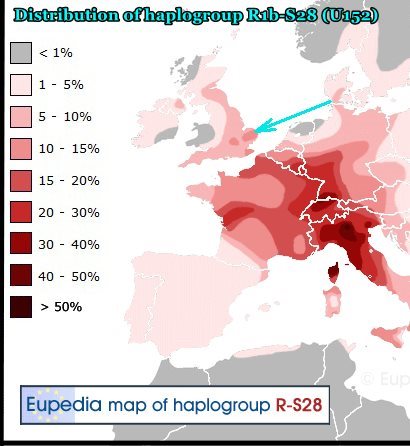

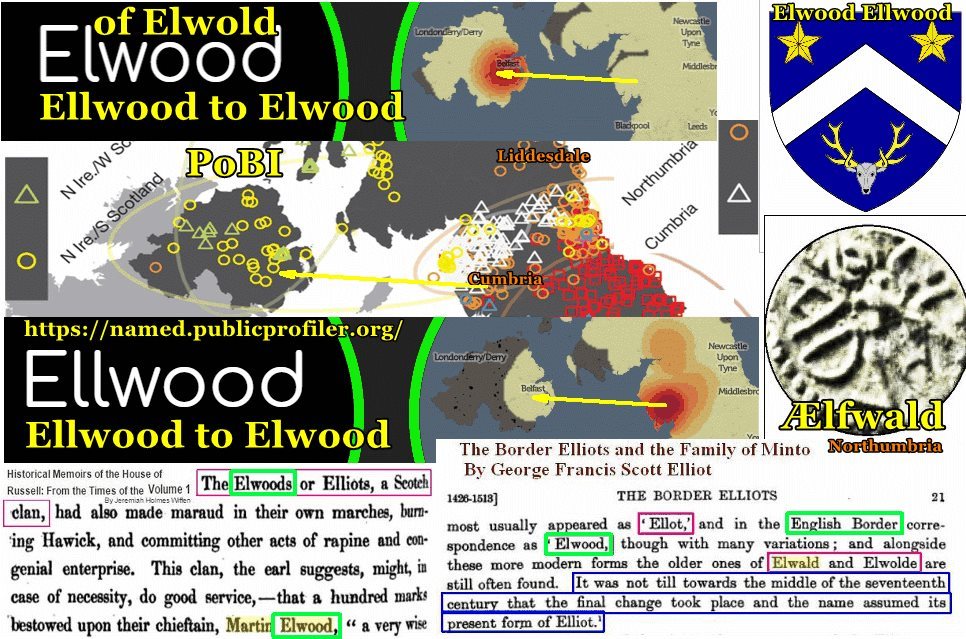



YORKSHIRE East Riding BRIGHAMS
The history of the Brigham family; a record of several thousand descendants of Thomas Brigham the emigrant, 1603-1653 : Brigham, Willard Irving Tyler, 1859-1904 : Free Download, Borrow, and Streaming : Internet Archive
Archeologist and Scottish Border Ballad singer.
nvk.genealogy.net/map/1890:Pollok,1890:Pollock,1890:Pollack,1890:Polk
https://en.wikipedia.org/wiki/File:Sasine_deed_1484_for_Robert_Elwald_(Elliot),_Redheugh,_Larriston,_Hartsgarth.jpg
Meyers Gazetteer
Correction; Archibald Bell the Cat, killing Spens of Kilspindie.
Kilspindie Castle | Aberlady | The Castles of Scotland, Coventry | Goblinshead
29th Margaret Eliott of Redheugh, obtained from Archibald Bell the Cat. Families seem to like to fight.
Correction; Archibald Bell the Cat, killing Spens of Kilspindie.
Kilspindie Castle | Aberlady | The Castles of Scotland, Coventry | Goblinshead
29th Margaret Eliott of Redheugh, obtained from Archibald Bell the Cat. Families seem to like to fight.
20181107, Wednesday, November 7, 2018, Boston, MA, USA, Brigham Health, Brigham and Women’s Hospital, Brigham Research Institute held their annual Discover Brigham campus-wide research day on Wednesday November 7, 2018.
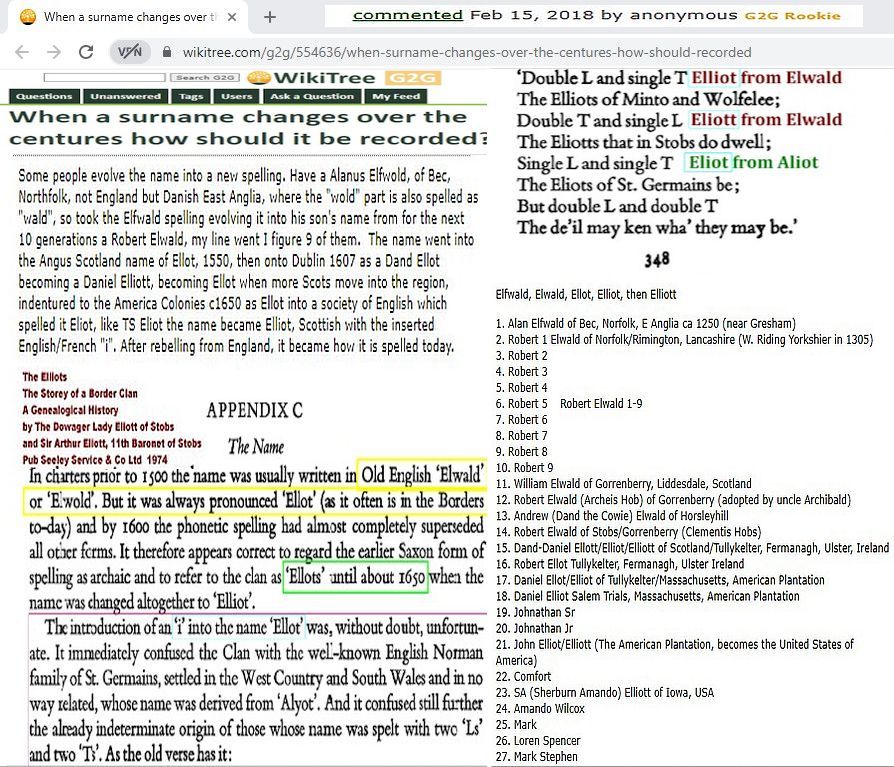
WikiTree
Your user name or IP address has been blocked by a WikiTree Leader.
https://www.wikitree.com/wiki/Category:Clan_Elliot
Start of block: 21:01, 14 May 2018
Intended for: Elliott-11757
Suspected violation: Intentionally adding false information
Accepting my standards, are Ancestry.com, 23andMe.com, FamilyTree.com, familysearch.org, and gedmatch.com [DNA# A269034(lawismarkellot) Ancestry.com data
M904357(markellott) 23andMe.com data corrective Genesis NM6772478 23andme Gedcom#4997456] Gedcom#4997456 (over 4,000 in data base). With FTDNA sites active in Germany, East Anglia, and Norfolk, assist on NC Argyll Colony.] Gedcom#4997456 (over 4,000 in Data base). With FTDNA sites active in Germany, East Anglia, and Norfolk, assist on NC Argyll Colony.Professional research genealogists not of Wikitree utilizing https://elwald.com/, and http://gorrenberry.com/, are readily capable to find documentation on anything I have presented on researching my Y-DNA, of Clan Elliot
In silencing by hanging Salem Witches, or in McCarthyism, blacklisting Jewish playwrights for being communists. In the behavior of science and long-term planning, it is felt I am being kicked out for ‘intentionally adding false information’, the concept of witch hanging and blacklisting was silencing. Owning and operating, elwald.com, gorrenberry.com and clancrozier.com, it is the owner operator which does the silencing. Don’t think I have been silenced. Sincerely, Mark Stephen Elliott 2-19-2023
by Loren Spencer Elliott;
DESCENDANTS OF JOSEPH AND ELIZABETH FRANKLIN
It was passed on to Naomi [ADAIR] HENDRICKSON from Ida Spencer HICKERSON that [#273.] Malinda Jane FRANKLIN wanted descendants to remember that she was a fifth cousin of BENJAMIN FRANKLIN. The “Portrait and Biographical Album” of Greene County, Ohio, lists George SHIGLEY, Jr., and calls attention that his mother [Malinda’s Aunt] [#252] Olivet [FRANKLIN] SHIGLEY was of “English descent, and a descendant of the family to which the famous philosopher, Benjamin Franklin, belonged.” A cousin, [#532.] Ann MALLETT, reported it had been handed down to her that they were related to the FRANKLIN that caught lightning in a jar!
by Loren Spencer Elliott;
NOTE: Thanks must be given to the many people that held this family in high regard and retained the available records.Included among this group is the second wife of #251. James SmythFRANKLIN – Mildred `Milly’ [QUICK]; her daughter – #273. Malinda Jane [FRANKLIN] SPENCER; Malinda’s granddaughter – #559. Ilah Malinda [SPENCER] ELLIOTT [My mother]; Mark S. ELLIOTT [this compiler’s son] who has researched Indiana records; #420. Ann MALLETT, 1156 East 58th St., Indianapolis, IN 46220 [gt-gr-daughter of #255. Rebecca (FRANKLIN) TRENARY]. Ann may have been researching this family longer than anyone living as she just celebrated her 78th birthday 24 Dec 1984. The most recent contributor, a descendant of #272. Henry H. FRANKLIN, isRoberta Jo HAWK, MD, 6048 Chandler Dr., Baton Rouge, LA 70808 (1996).> Loren Spencer Elliott
Яркая долина
https://nvk.genealogy.net/map/1890:Hellenthal
https://www.google.com/maps/place/53940+Hellenthal,+Germany/@50.4186222,6.3085769,11z/
https://clancrozier.com/wp-content/uploads/2023/01/Garrett-Hellenthal-The-Genetic-History-of-the-United-Kingdom-the-POBI-project.mp4
https://gorrenberry.com/wp-content/uploads/2019/08/Garrett-Hellenthal-The-Genetic-History-of-the-United-Kingdom-the-POBI-project.mp4?_=1
Download Portable ScreenHunter Free 5.1.147 (softpedia.com)
https://www.findagrave.com/memorial/38734448/albert-bird-armstrongal
In lieu of flowers the family suggests contributions to the Armstrong surname genealogical organization. Funeral directors, Deseret Mortuary.
Beccleuch warden of West March, Duke of Buccleuch of the Bauld (Bold) Buccleuch, has his home in Langholm, Scotland the hometown of Neil Armstrong.
Armystand 1396 (army-stand along Liddel Water), Armestrang (Arme-strang army-strong, strang and lang are strong and long in Scottish Auld and Bauld are Old and Bold in Scottish, like in Robert Burns ‘Auld Lang Syne’, ‘Old Long Since’.
References;(in the public domain) The history of Enniskillen with reference to some manors in co. Fermanagh, and other local subjects by Trimble, William Copeland, 1851-1941 page 218-9 https://archive.org/details/historyofenniski00trimrich/page/218/mode/2up
The History of Liddesdale, Eskdale, Ewesdale, Wauchopedale and the Debateable Land: By Robert Bruce Armstrong, Volume 1883 page 65 https://books.google.com/books?id=nFr7oQEACAAJ&pg=PA65&source=gbs_toc_r&cad=4#v=onepage&q&f=false Chronicles of the
Armstrongs; by Armstrong, James Lewis 1902 https://archive.org/details/chroniclesofarms00arms/page/259/mode/2up
id=nFr7oQEACAAJ&pg=PA65&source=gbs_toc_r&cad=4#v=onepage&q&f=false Chronicles of the
Armstrongs; by Armstrong, James Lewis 1902 https://archive.org/details/chroniclesofarms00arms/page/259/mode/2up
Search the Muster Rolls (therjhuntercollection.com)